Vol. 68, No. 18 (2019)
2019-09-20
INVITED REVIEW
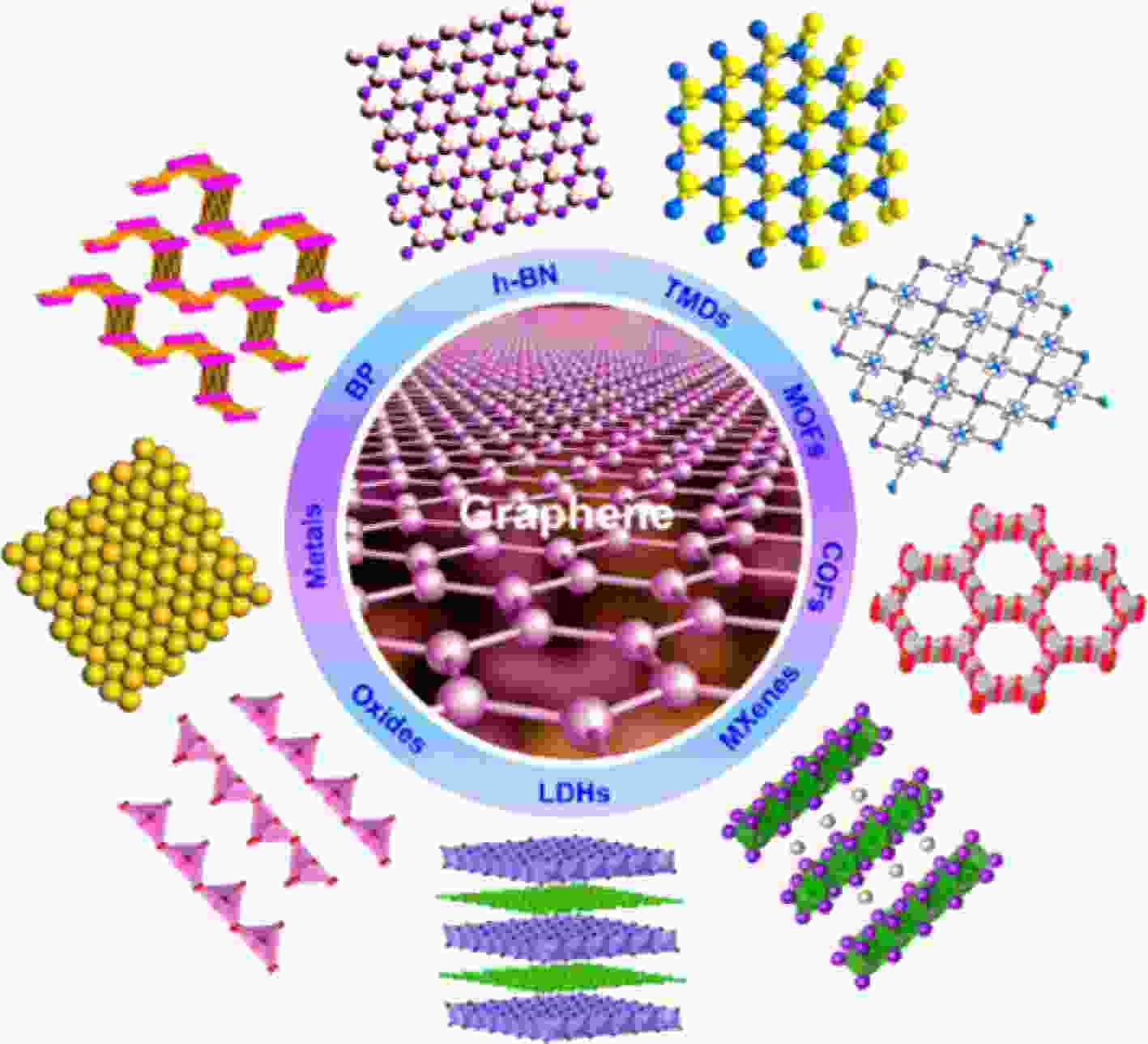
EDITOR'S SUGGESTION
2019, 68 (18): 188101.
doi:10.7498/aps.68.20190751
Abstract +
Ultrafast pulse laser has been widely used in many fields, such as optical communications, military and materials processing. Semiconductor saturable absorber mirror (SESAM) serving as a saturable absorber is an effective way to obtain ultrafast pulse laser with ps-level pulse width. The SESAM needs specially designing to meet different wavelength operations. And the low damage threshold and high fabrication cost of SESAM hinder its development. Exploring novel materials is becoming a hot topic to overcome these drawbacks and obtain ultrafast laser with excellent performance. The discovery of graphene opens the door for two-dimensional nanomaterials due to the unique photoelectric properties of layered materials. Subsequently, two-dimensional (2D) materials such as topological insulators, transition metal sulfides, and black phosphorus are reported. These materials are used as saturable absorber to obtain a pulsed laser. In this paper, we summarize the research status of fiber lasers and solid-state lasers based on 2D materials in recent years. The development status of the lasers in terms of central wavelength, pulse width, repetition frequency, pulse energy and output power are discussed. Finally, the summary and outlook are given. We believe that nonlinear optical devices based on 2D materials will be rapidly developed in the future several decades
GENERAL
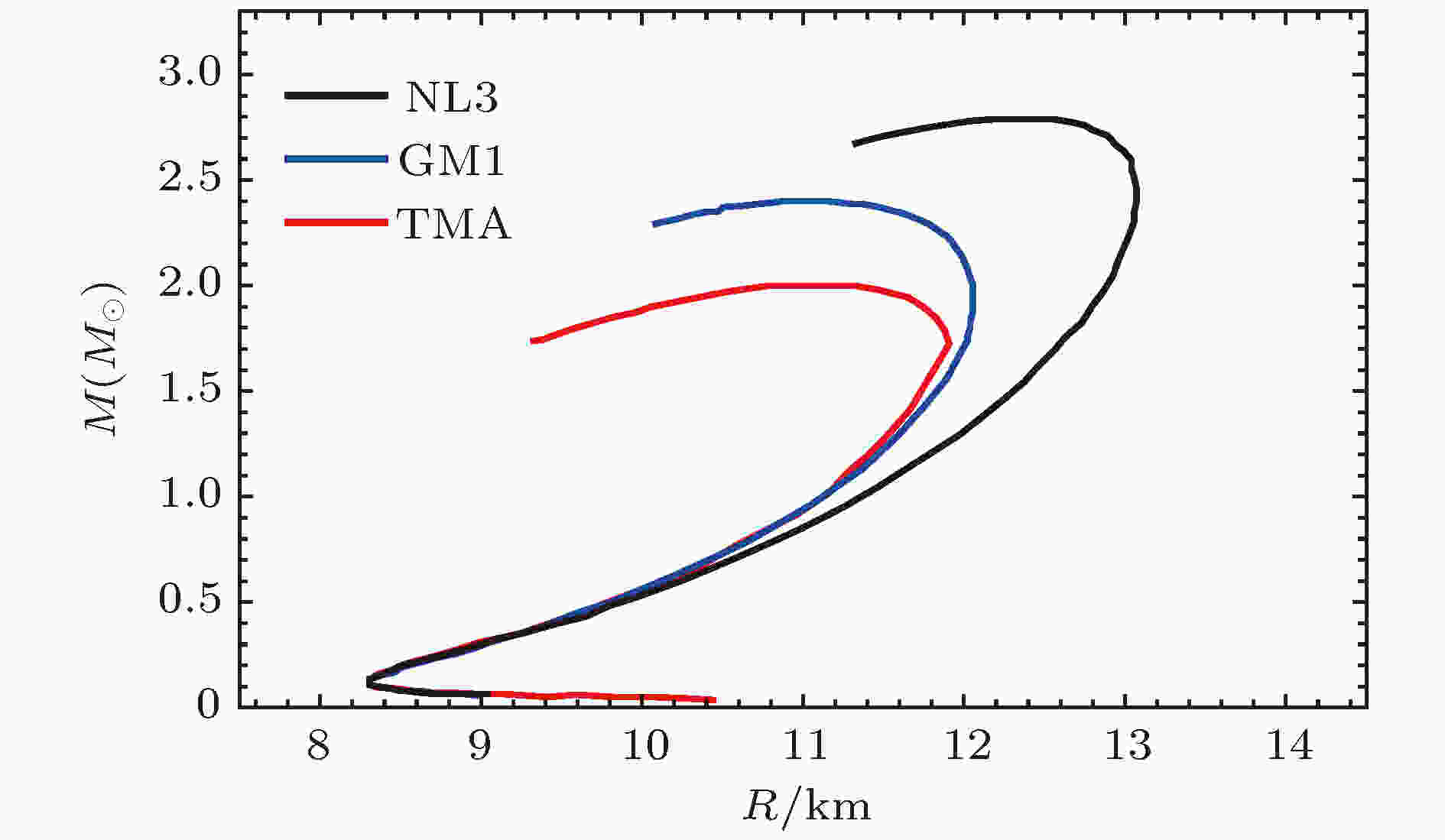
2019, 68 (18): 180401.
doi:10.7498/aps.68.20190760
Abstract +
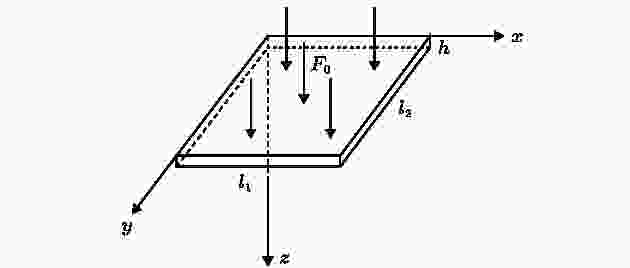
2019, 68 (18): 180501.
doi:10.7498/aps.68.20190155
Abstract +
The unique global properties of shape memory alloy are mainly derived from the martensite phase transition and its inverse, which result from the change of temperature and external load. In this paper, the global characteristics of shape memory alloy thin plate system are analyzed with the temperature and harmonic excitation amplitude as control parameters. Based on the method of Poincare map, the complex crisis phenomenon of the system including the sudden change in number, size and type of attractors can be observed through the global multivalued bifurcation diagram. However, the specific crisis type is not clear, it is necessary to be analyzed from the global viewpoint. By computing the global diagram with the composite cell coordinate system method which constructs a composite cell state space by multistage division of the continuous phase space, the attractors, saddles and basins of attraction of the system can be obtained more accurately. The vivid evolutionary processes of the crisis phenomena of the system are illustrated, and it can be found that the system presents a complex global structure with amplitude and temperature changing. There exist two kinds of crises: one is the boundary crisis resulting from the collision between a chaotic/periodic attractor and a chaotic saddle within the basin boundary, which causes the attractor to vanish, and the other is the merging crisis caused by the collision of two or more attractors with the chaotic saddle within the basin boundary where a new chaotic attractor appears. When multiple attractors coexist in the system, the basin boundary may be smooth or fractal, and for any point at boundary, its small open neighborhood always has a nonempty intersection with three or more basins, which is known as Wada basin boundary. It is difficult to predict the dynamic behavior of the system accurately due to the fractal, the Wada-Wada, Wada-fractal and fractal-Wada basin boundary metamorphoses which can be observed along with the variation of temperature and amplitude through the composite cell coordinate system method, which owns a unique advantage in depicting basin boundary. Furthermore, the Wada property is displayed more clearly by refining specified region. The results of this paper provide a theoretical analysis tool for adjusting the dynamic response of shape memory alloy thin plate system and optimizing the deformation and vibration control of mechanical equipment through controlling temperature and excitation intensity.

2019, 68 (18): 180502.
doi:10.7498/aps.68.20190197
Abstract +
It has been found in many experimental and theoretical studies that autapse regulates the electrical activities of single neurons and the spatiotemporal behaviors of neuronal networks through feedback or coupling currents to achieve physiological functions. In the present paper, the effect of inhibitory self-feedback on spiking patterns near Hopf bifurcation point is studied in the deterministic Morris-Lecar model and the stochastic Morris-Lecar model, and the dynamical mechanism is acquired with the phase response curve (PRC) of spiking to the inhibitory square pulse current stimulation. The inhibitory self-feedback current with a suitable time-delay can induce the spiking frequency to increase, which is different from the traditional viewpoint that the inhibitory stimulations often induce the firing frequency to decrease. For the remained time delays, spiking frequency decreases. Furthermore, the changes of spiking frequency, induced by the inhibitory self-feedback current, can be well explained with the dynamical responses of the spiking pattern of a single neuron without autapse to an inhibitory square pulse current stimulation. For the spiking pattern of a neuron without autapse, when an inhibitory square pulse stimulation current resembling to the inhibitory self-feedback current is applied at some suitable phases after an action potential/spike, the phase of the action potential/spike following the square pulse current advances, which leads the interspike intervals (ISIs) to decrease and firing frequency to increase. For the remained stimulation phases of the inhibitory pulse current, the response phase of the following action potential/spike delays. Therefore, the PRC of the action potential/spike shows the characteristics of type-II excitability corresponding to Hopf bifurcation. The stimulation phase of the inhibitory square pulse current that can induce the spiking frequency of single neurons to increase corresponds to the time delay of inhibitory self-feedback that can enhance firing frequency, which shows that the type-II PRC is the cause that the inhibitory self-feedback can induce the spiking frequency to increase. Finally, when noise is introduced into the ML model with inhibitory self-feedback, the coefficient of variation (CV) of theISIsis smaller for the longer time delay of the self-feedback or the stronger coupling strength of the autapse, that is, the spike-timing precision is improved for the smallerCVofISIs. Such a result is consistent with the experimental result that slow inhibitory autapse can enhance spike-timing precision. The results present a novel phenomenon that negative self-feedback can enhance the response of the system and the corresponding nonlinear dynamical mechanism, i.e. the PRC, provide a new method of regulating the neural electrical activities, and are helpful in understanding the potential function of inhibitory autapse.

2019, 68 (18): 180503.
doi:10.7498/aps.68.20190308
Abstract +
In this paper, we discuss the optimization problem of the synchronization for Kuramoto oscillators in coupled star networks. In previous studies of star networks, the natural frequencies of leaf nodes are usually equal or only adjusted within a small parameter range, but this assumption is not satisfied in most of cases. Considering the random distribution of the frequency of the leaf nodes in a single star network and multiple coupled star networks, the critical coupling strength required for system synchronization is obtained according to the boundedness of the sinusoidal function. In a single star network, the piecewise linear relationship between the critical coupling strength of the system and the frequency of the central oscillator is found. In the coupled system of two star networks, we consider that they are coupled through the central node. The parameter plane of the natural frequency of the central node will be divided into different regions. In each region, the critical coupling strength is determined by the coupling strength within the respective star networks or the coupling strength between the two central nodes. Considering the coupling of multiple star networks, we introduce a central connection node through which the central nodes of multiple star networks are coupled. In the above two models of multiple coupled star networks, the piecewise linear relationship between the critical coupling strength of the system and the sum of frequencies of the center oscillators is found. The critical coupling strength of the two types of networks is smallest at the piecewise point. According to the optimization results, we find that with the increase of coupling strength, when there is only one cluster in the system, the critical coupling strength becomes small. So we can reduce the critical coupling strength of the system by adjusting the frequency of the central oscillator for achieving the effect of synchronous optimization. When multiple clusters are generated in the system, the critical coupling strength turns large. Because of the similarity between star network and scale-free network and the application of Kuramoto model in power grid, this paper can provide a good theoretical reference for the further study on synchronization optimization of scale-free network and power grid.

2019, 68 (18): 180504.
doi:10.7498/aps.68.20190397
Abstract +
For the saturated vapor condensation on the cooled surface, the evolution mechanism of vapor molecular in the transition zone between the bulk phase and the cooled surface is not clear yet. The molecular clustering model considers that the vapor molecules first form clusters in the gas phase before condensing on the cooled surface. However, it is difficult to observe the dynamic evolution of nanoparticles in the near-wall boundary layer, hence, the experimental verification about this model is not sufficient now. Based on the hydrogen bonded network formed inside the cluster, in this paper, the attenuated total reflection Fourier transform infrared spectroscopy is introduced to follow and detect the dynamic behavior of vapor molecules in the near-wall thin layer during the condensation process. The infrared spectra of the gas phase at different positions from the cooled surface during the condensation process are obtained. The experimental results directly verify the distribution of clusters in the near-wall region, indicating that clusters are the main units of vapor condensation and droplet growth. Moreover, the average cluster sizenincreases gradually along the direction near the cooled surface. Based on the hydrogen bond characteristics of clusters, the ethanol molecular clustering near the surface is also observed, which further verifies the rationality of this model. In addition, it’s found that the distribution region along the cooled surface of ethanol clusters during the process of condensation is smaller than that of water clusters under the same condition. This may indirectly indicate that the heat transfer boundary layer of ethanol vapor condensation is thinner than that of water vapor condensation, resulting in its weaker performance of heat transfer. This method, where we use the microstructures manufactured on the surface to regulate the distribution of clusters in the near-wall region, will provide a new insight into enhancing the process of steam condensation with non-condensable gas or efficient water capture from air.
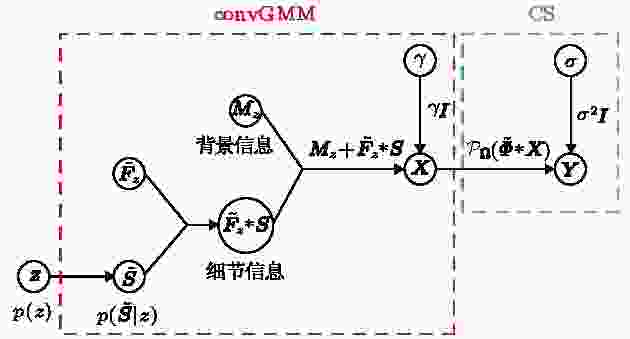
2019, 68 (18): 180701.
doi:10.7498/aps.68.20190414
Abstract +
Statistical compressive sensing needs to use the statistical description of source signal. By decomposing a whole image into a set of non-overlapping or overlapping patches, the Gaussian mixture model (GMM) has been used to statistically represent patches in an image. Compressive sensing, however, always imposes compression on the whole image. It is obvious that the entire image contains much richer information than the small patches. Extending from the small divided patches to an entire image, we propose a convolutional Gaussian mixture model (convGMM) to depict the statistics of an entire image and apply it to compressive sensing. We present the algorithm details by learning a convGMM from training images based on maximizing the marginal log-likelihood estimation. The learned convGMM is used to perform the model-based compressive sensing by using the convGMM as a model of the underlying image. In addition, aiming at the problem of high-dimensional image that makes learning, estimation and optimization suffer high computational complexity, all of the training and reconstruction process in our method can be fast and efficiently calculated in the frequency-domain by two-dimensional fast Fourier transforms. The performance of the convGMM on compressive sensing is demonstrated on several image sets.
THE PHYSICS OF ELEMENTARY PARTICLES AND FIELDS
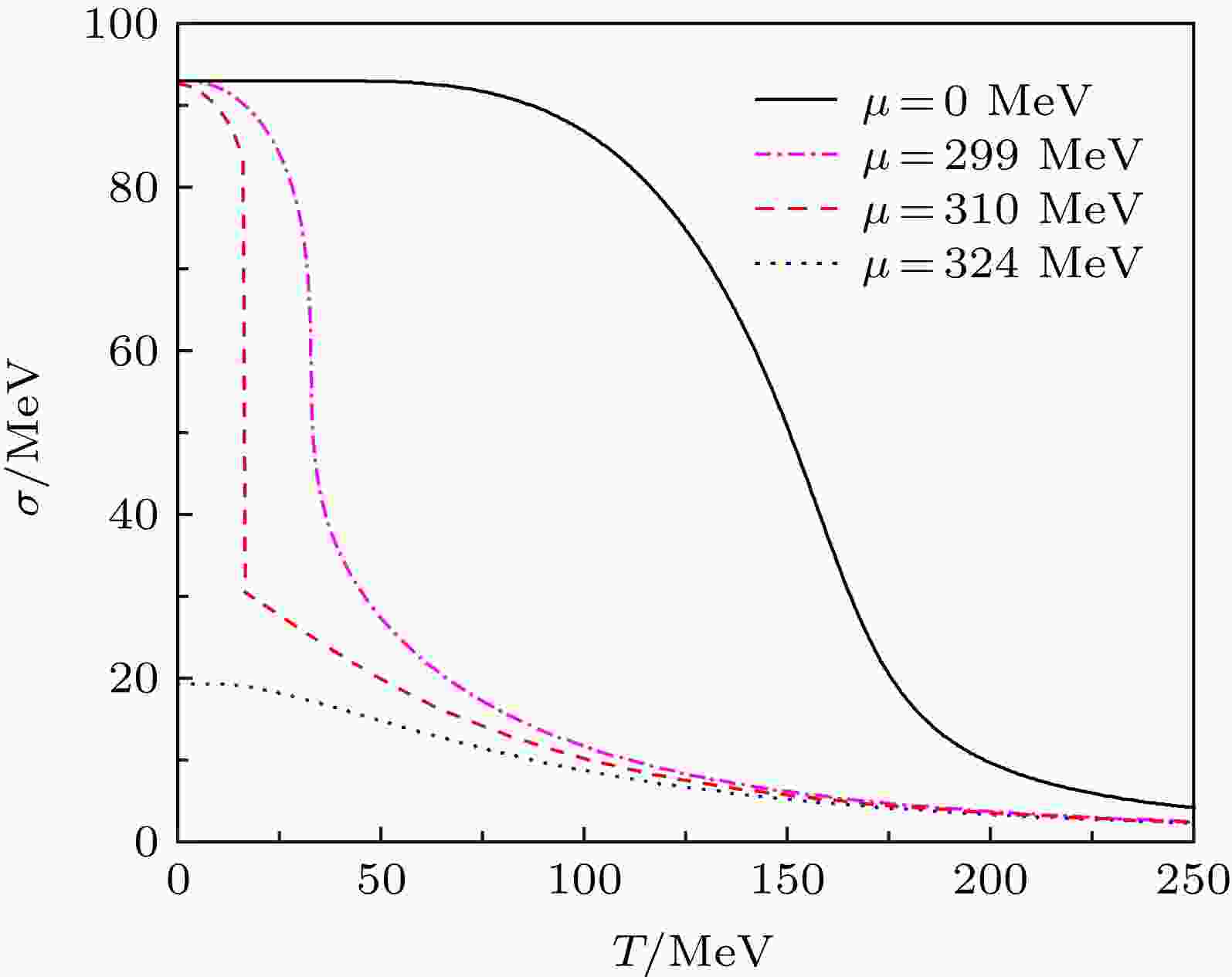
2019, 68 (18): 181101.
doi:10.7498/aps.68.20190798
Abstract +
In a mean-field approximation, we study the in-medium effective potential of the two-flavor quark meson model in the presence of a fermionic vacuum term at a finite temperature and density. There exists a crossover phase transition in the low-density region, and also there is a first-order phase transition in the high-density region accompanied by a critical end point. For the first-order phase transition, when the temperature is close to the critical temperature, the values of surface tension are calculated at various chemical potentials and we find that our results are very close to the results recently found in other chiral models with two flavors. Some consequences and possible applications of our results are also pointed out for the experiments on heavy ion collisions and the evolutions of the compact stars in their early stages.
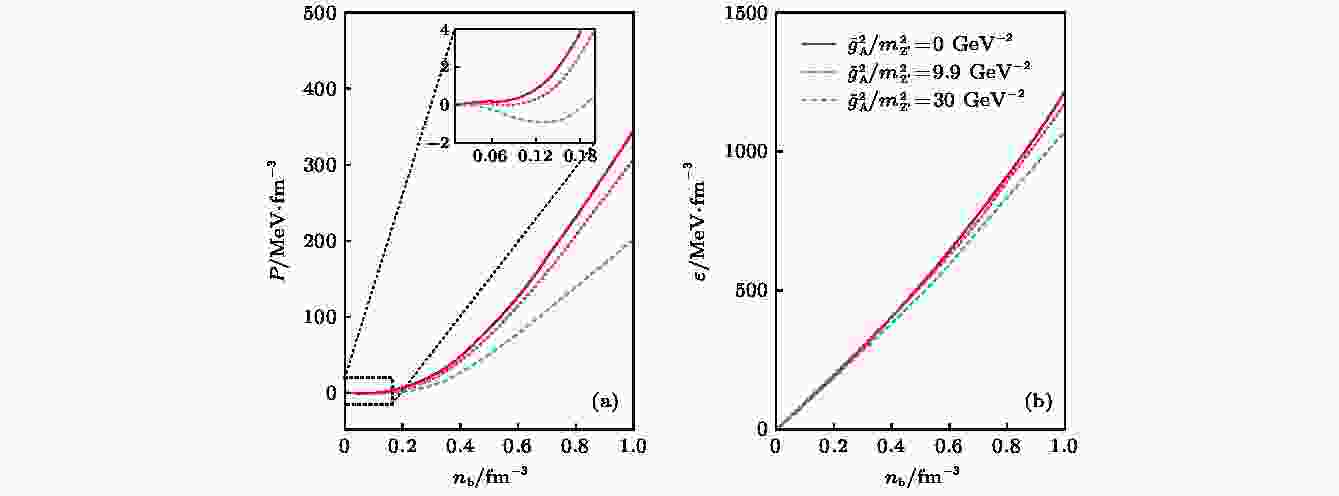
2019, 68 (18): 181102.
doi:10.7498/aps.68.20190477
Abstract +
It is predicted in many theories beyond the standard model that the new interaction relevant to spin is existent. The exchange of an axial vector particle will result in attractive dipole-dipole interaction which can be viewed as an effective magnetic potential that looks quite different from those expected from electromagnetism. In this work, we demonstrate that, instead of the laboratory spin source, stringent constraints can be set on these attractive spin-spin interactions from polarized nuclear matters within neutron stars which have extremely strong magnetic fields (up to 1015G in some cases). By considering such an exotic interaction within the framework of relativistic mean field model, we find that the stability of infinite nuclear matter can be influenced significantly when the ratio of coupling strength to boson mass become larger than
$g_{\rm A}^2/m_{\rm Z'}^2 \sim {\cal O}(10 \, {\rm GeV^{-2}})$
. Furthermore, based on the curvature matrix approach, when
$g_{\rm A}^2/m_{\rm Z'}^2 > 130 \, {\rm GeV^{-2}}$
, phase transition inside low-density nuclear matter will no longer take place before the pressure of nuclear matter becomes zero, which forbids core-crust transition at the inner edge separating the liquid core from the solid crust of neutron stars. Thus bare neutron stars without any crusts are predicted. However, observations of pulsar glitches, i.e., the occasional disruptions of the extremely regular pulsations from magnetized, rotating neutron stars, imply the existence of crusts inside these dense objects. This in turn constrains the strength of the exotic interaction. In fact, in the case of dipole-dipole force on a length scale between µm to cm, the highest value of these constraints can be 8 orders of magnitude higher than those from existing laboratory results.
ATOMIC AND MOLECULAR PHYSICS
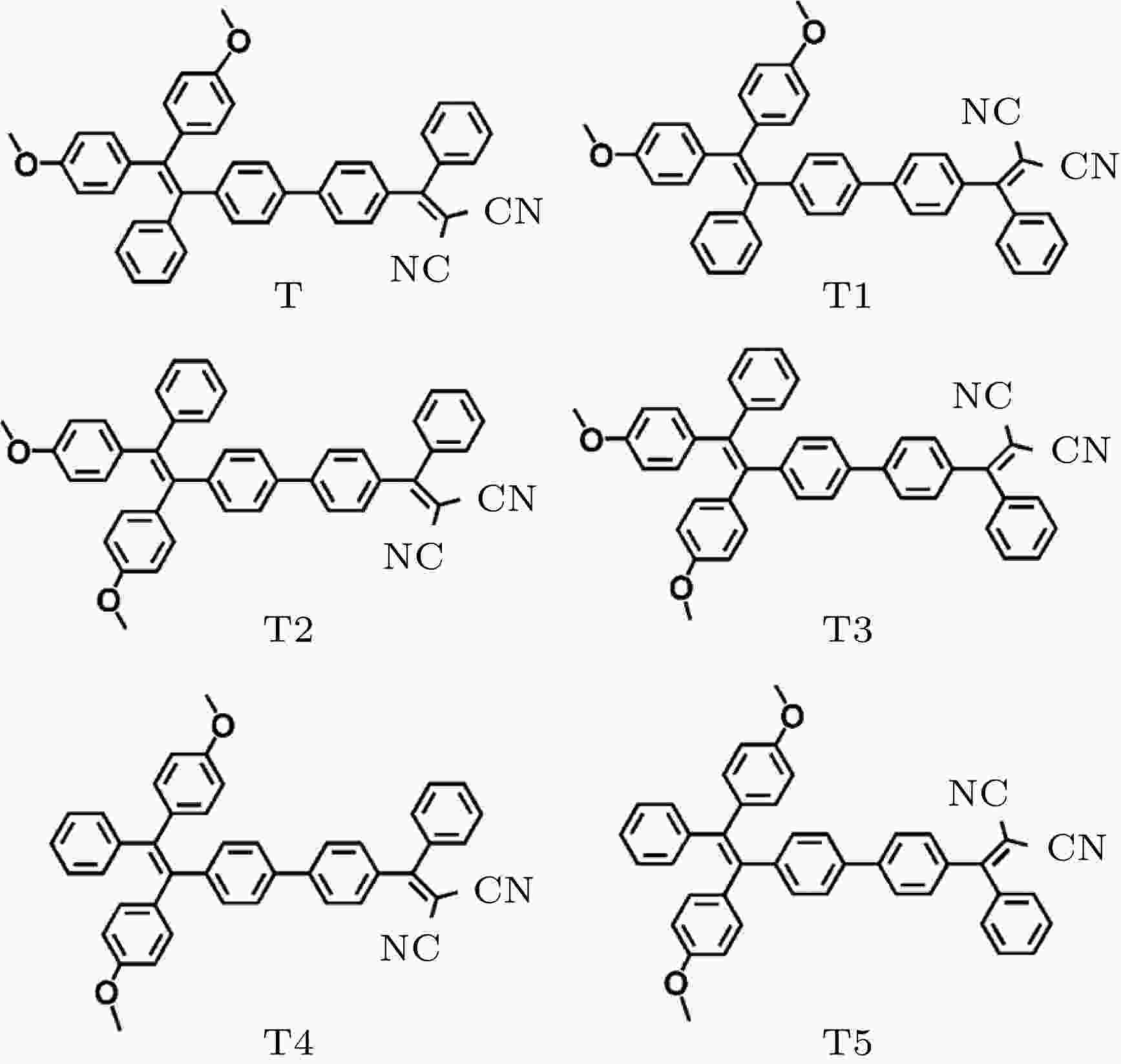
2019, 68 (18): 183101.
doi:10.7498/aps.68.20190471
Abstract +
Organic materials with strong two-photon absorption response and aggregation induced emission have aroused a great deal of interest in recent years, for their many potential applications such as two-photon fluorescence microscopy, up-conversion laser, photodynamic therapy, etc. The tetraphenylethylene units are usually employed in two-photon absorption and aggregation induced emission materials because of their good electron-donating capability and special propeller starburst structures. Theoretical study on the relationship between molecular structure and two-photon absorption property is of great importance for guiding the experimental design and synthesis of functional materials. In this paper, the two-photon absorption properties of a series of organic molecules containing tetraphenylethylene and cyano groups are studied by employing the density functional response theory in combination with the polarizable continuum model. The molecular geometries are optimized at a hybrid B3LYP level with 6-31g(d, p) basis set in the Gaussian 16 program. The two-photon absorption cross sections are calculated by response theory through using the CAM-B3LYP functional with 6-31g(d) basis set in the Dalton program. The effect of donor position and number on two-photon absorption properties are investigated. In addition, by increasing the planarity and conjugated length of the molecule, as well as by enhancing the strength of the electron donor, we design three molecular structures and calculate their two-photon absorption properties. The results show that the donor position and number have important effects on two-photon absorption properties. The methoxy donor at the end of the molecule can increase the two-photon absorption intensity effectively. As the number of substituents increases, the position of the two-photon absorption peak is red-shifted. The effects of adding electron donor groups on different side positions have a significant difference in the two-photon absorption property. Comparing with the experimental molecules, the two-photon absorption cross sections of the designed molecules are greatly enhanced. When the tetraphenylethylene group is replaced by the triphenylamine group, the two-photon absorption peak is greatly red-shifted, and the two-photon absorption intensity is significantly increased. Since all of these molecules contain tetraphenylethylene or triphenylamine group with propeller structure, they can have both two-photon absorption and aggregation induced emission properties. This study provides theoretical guidelines for synthesizing a new type of active two-photon absorption and aggregation induced emission material.
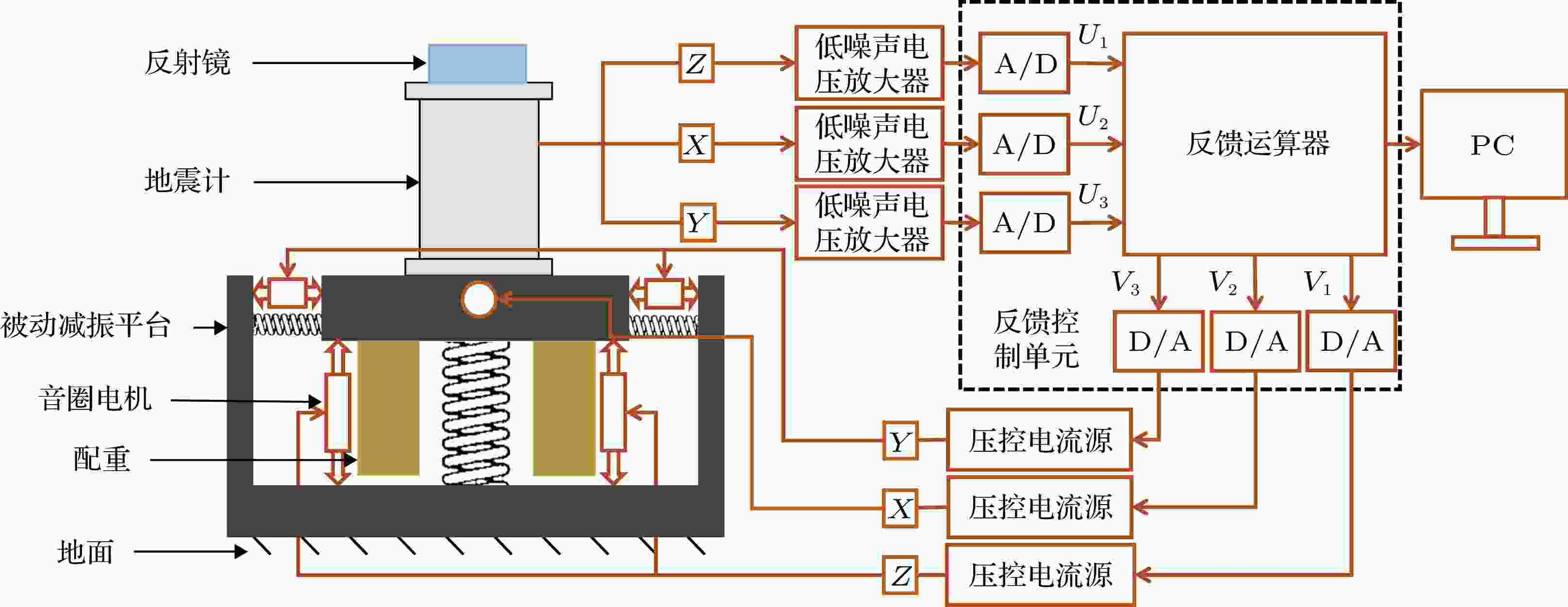
A mobile three-dimensional active vibration isolator and its application to cold atom interferometry
2019, 68 (18): 183301.
doi:10.7498/aps.68.20190443
Abstract +
Vibration noise has an influence on the sensitivity and stability for many precision instruments, especially for atom interferometers. In this paper, a mobile three-dimensional active vibration isolation system is established for portable atom interferometer that is effectively isolated from the ground vibration, thereby improving the sensitivity of the portable atom interferometer, and can be deployed and recovered to working state rapidly. With the home-developed integrated feedback algorithm, this system achieves a good vibration suppression in a wide frequency range in three directions. It suppresses the ground vibration by three orders of magnitude in the vertical direction, and one order of magnitude in the horizontal direction. In a frequency range less than 10 Hz which the atom interferometer is sensitive to, the vibration noise is suppressed to 4.8 × 10–9m/s2/Hz1/2in the vertical direction and to 2.7 × 10–7m/s2/Hz1/2in the horizontal direction. The influence of vibration noise on the sensitivity of the atom interferometer reaches to 2 μGal/Hz1/2, which is reduced by two orders of magnitude compared with the result without our system.
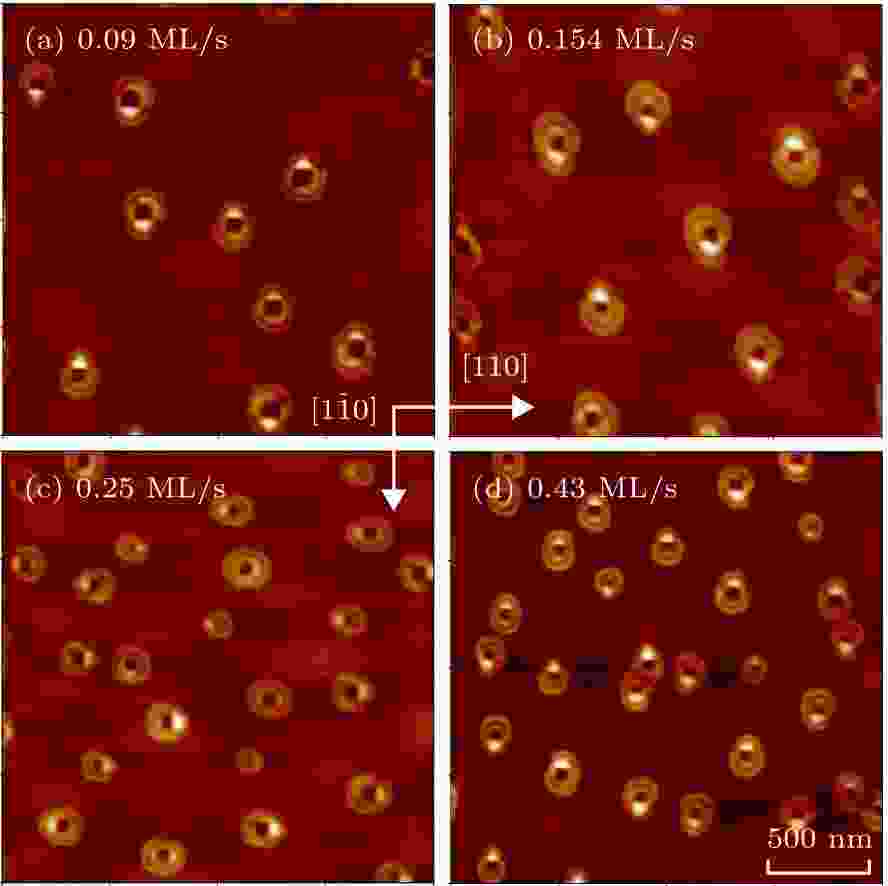
2019, 68 (18): 183601.
doi:10.7498/aps.68.20190615
Abstract +
For the fabrication of particular nanostructures, Stranski-Krastanov (SK) growth mode driven by strain is most widely used. Meanwhile, another technique that is used to form the complex nanostructures is the droplet epitaxy technique, which is based on the deposition of group III element nanoscale droplets onto substrate and followed by the reaction with group V element for crystallization into III-V compound nanostructures. Droplet epitaxy technique is simple and flexible, and it does not require additional complicated processing and has potential to develop various quantum nanostructures. It, unlike standard MBE growth, exploits the sequential supply of group-III and group-V elements to form quantum nanostructures. Quantum rings are a special class of quantum-confinement structure that can be fabricated by the droplet epitaxy technique and have attracted wide attention due to the Aharonov-Bohm effect, which is specific to the topology of a ring. In this paper, GaAs/GaAs (001) concentric quantum double rings (CQDRs) are prepared by droplet epitaxy technique at different Ga droplet deposition rates in monolayer per second (ML/S). The 2 μm × 2 μm atomic force microscope images are obtained to show the morphologies of CQDRs. We study the effects of Ga droplet deposition rates (0.09 ML/s, 0.154 ML/s, 0.25 ML/s, 0.43 ML/s) on CQDRs. The results show that with the increase of Ga droplet deposition rate, the density of CQDRs increases and the radius of inner ring and the radius of outer ring decrease. According to the nucleation theory, through the relationship between the maximum cluster density and the Ga droplet deposition rate, the critical number of atom nucleations is found to be 5, which suggests that the stable Ga atom crystal nucleus should contain at least 5 Ga atoms in the process of forming Ga droplet, and a nucleation state transformation diagram is drawn in order to obtain an insight into the process of forming Ga droplet according to the nucleation theory and fitting results. The research results could be instructive for preparing the GaAs concentric quantum double rings that the density can be controlled by droplet epitaxy.
ELECTROMAGNETISM, OPTICS, ACOUSTICS, HEAT TRANSFER, CLASSICAL MECHANICS, AND FLUID DYNAMICS
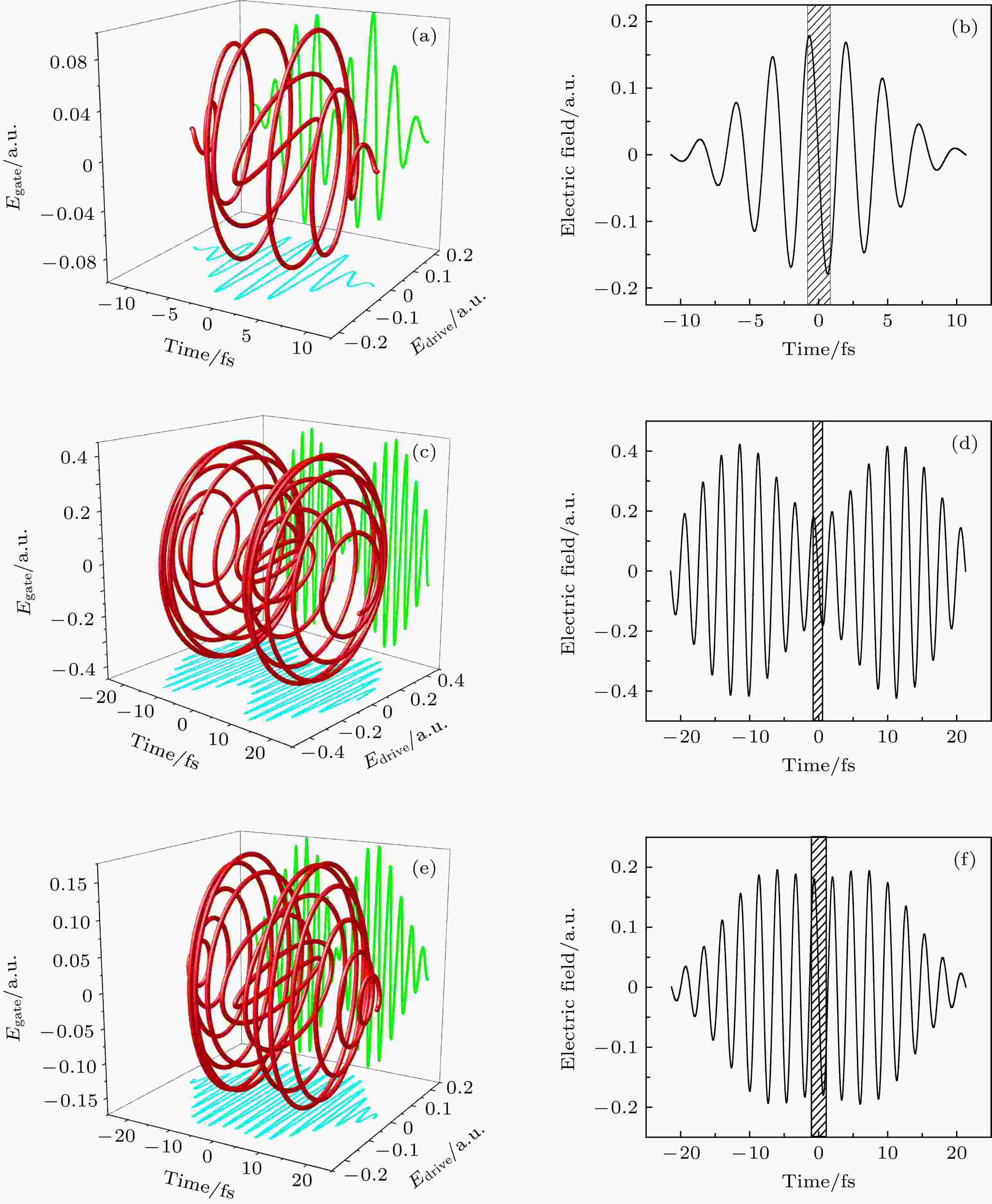
2019, 68 (18): 184201.
doi:10.7498/aps.68.20190392
Abstract +
Isolated attosecond pulses make it possible to study and control the ultrafast electron processes in atoms and molecules. High order harmonic generation (HHG) is the most promising way to generate such pulses, which is benefited from the broad plateau structure of the typical HHG spectrum. In previous HHG studies on the polarization gating pulse with longer pulse duration, one needs to dramatically increase the separation in time between the two counter-rotating circularly-polarized pulses to generate the nearly-linear half-cycle " polarization gate”. This leads to a low harmonic conversion efficiency because the field outside the polarization gate is much stronger than inside the polarization gate. In this paper, by using Lewenstein model, we theoretically simulate the high-order harmonic generation from helium atom subjected to the polarization gating pulse with 10 fs pulse duration. It is found that high-order harmonic spectra each with a higher efficiency and regular structure can still be obtained by reasonably adjusting the delay time ratio and the amplitude ratio of electric fields between the two counter-rotating pulses. Further, a single 175 as pulse in the time domain is obtained by Fourier transforming the 80th order harmonics into the 172nd order harmonic without compensating for the harmonic chirp. This scheme has two main advantages. First, the adjustment of the polarization gate width from half optical cycle into nearly one cycle ensures higher intensity of the synthesized electric field inside the polarization gate. Second, the suitable adjustment of the amplitude ratio between two electric fields ensures the low ionization probability before the polarization gate, and thus further fulfills the harmonic phase matching condition in the process of the propagation.
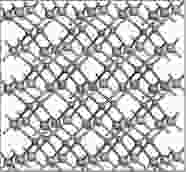
2019, 68 (18): 184202.
doi:10.7498/aps.68.20190290
Abstract +
The electronic structures and optical properties of transition metal (TM, TM refers to Fe, Co, and Ni, respectively) doped GaSb are studied by the LDA+Umethod of the first-principles calculation. The results indicate that these TMs can enhance the absorption amplitudes of GaSb semiconductors in the infrared region, and improve the photocatalytic performances of GaSbs effectively. For the doped systems, TMs tend to substitute for Ga and form TM@Ga defect. The charge layout and bond population of TMs imply that the electric dipole moment induced by lattice distortion separates photoelectrons from holes to some degree, and consequently enhancing the photocatalytic performance. The impurity levels induced by TMs are close to the Fermi level, which illustrates that the imaginary part of complex dielectric function has the capability of response when the energy of photon is zero. Meanwhile, the static dielectric constant of the doped system is also enhanced compared with that of the un-doped system. The doped TMs can improve the optical properties of GaSb systems for three dopants effectively, but the Ni dopant is the best for the photocatalysis properties of GaSb in the three dopants. The further analysis shows that the uniform Ni can hinder the recombination of electron-hole pairs, and the optical absorption range and absorption peak are both biggest when Ni molar concentration is 10.94%, which is favorable for photocatalytic performance. Our results will extend the applications of GaSb to the fields of infrared thermal photovoltaic cells, infrared light detector, and infrared semiconductor laser.
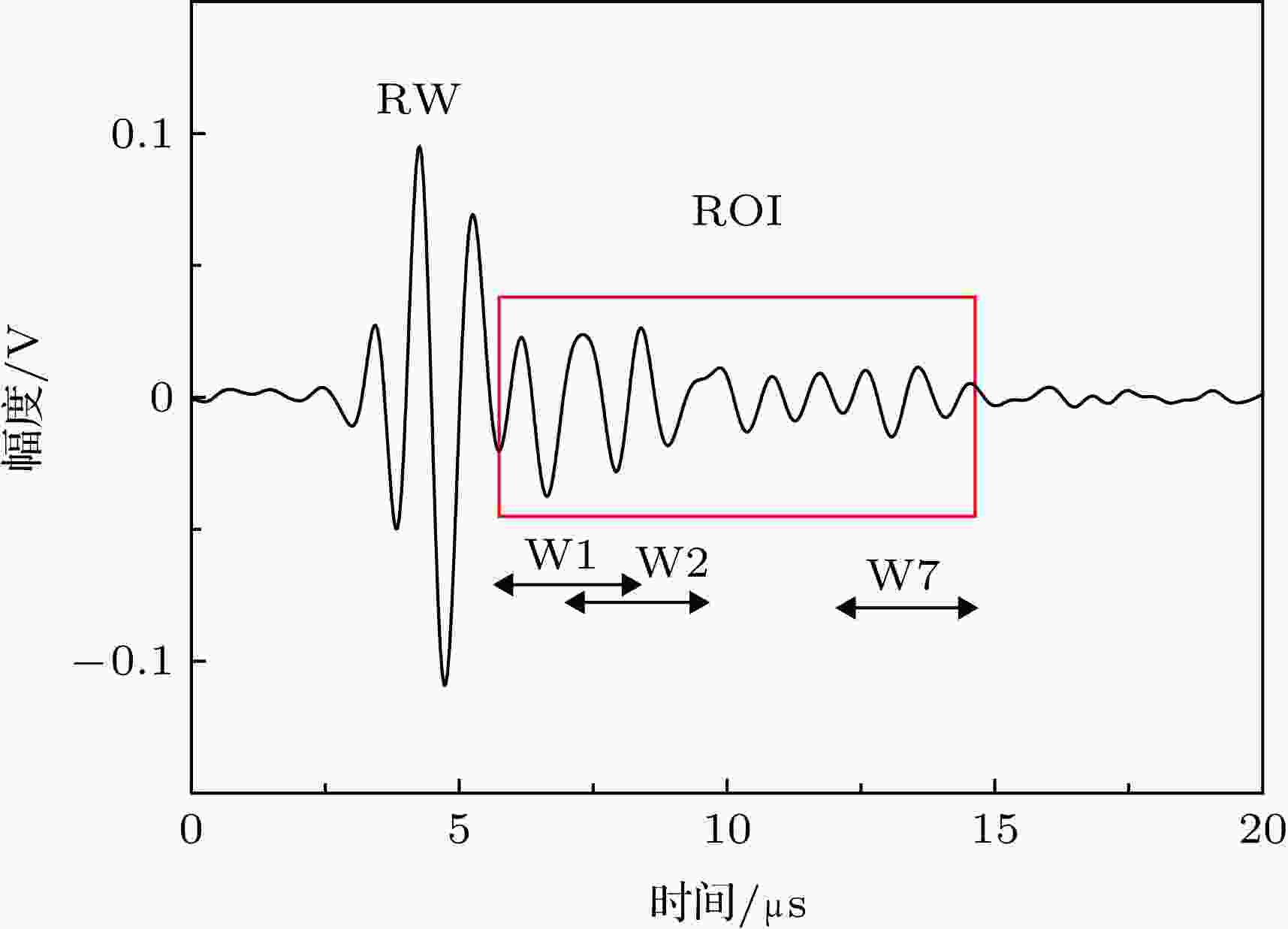
2019, 68 (18): 184301.
doi:10.7498/aps.68.20190599
Abstract +
Ultrasonic backscatter has been gradually applied to the assessment and diagnosis of bone disease. The heavy frequency-dependent attenuation of ultrasound results in weak ultrasonic signals with poor signal-to-noise ratio and serious wave distortions during propagation in cancellous bone. Ultrasonic attenuation measured with the through-transmission method is an averaged result of ultrasonically interrogated tissues (including the soft tissue, cortical bone and cancellous bone). Therefore, the through-transmission measurements can not accurately provide ultrasonic attenuation of cancellous bone of interest. The purpose of this study is to estimate ultrasonic frequency-dependent attenuation with ultrasonic backscatter measurements and to compensate for the frequency-dependent attenuation in an ultrasonic backscatter signal from cancellous bone.In-vitroultrasonic backscatter and through-transmission measurements are performed on 16 cancellous bone specimens by using 1.0-MHz transducers. Spatial scans are performed in a 10 mm × 10 mm scanned region with a spatial interval of 0.5 mm for each bone specimen. The frequency slope of ultrasonic attenuation is measured with the ultrasonic through-transmission signals serving as a standard value. Four different algorithms (the spectral shift method, the spectral difference method, the spectral log difference method, and the hybrid method) are used to estimate the frequency slope of ultrasonic attenuation coefficient from ultrasonic backscatter signal. The results show that the frequency-dependent attenuation coefficient ranges from 2.3 dB/mm/MHz to 6.2 dB/mm/MHz for the bovine bone specimens. The through-transmission measured frequency slope of ultrasonic attenuation coefficient is (4.14 ± 1.14) dB/mm/MHz (mean ± standard deviation), and frequency slopes of ultrasonic attenuation coefficient are estimated by four backscattering methods to be (3.88 ± 1.15) dB/mm/MHz, (4.00 ± 0.98) dB/mm/MHz, (3.77 ± 0.84) dB/mm/MHz, and (4.05 ± 0.85) dB/mm/MHz, respectively. The estimated frequency-dependent attenuation is significantly correlated with the standard attenuation value (R= 0.78-0.92,p< 0.01), in which the spectral difference method (R= 0.91,p< 0.01) and the hybrid method (R= 0.92,p< 0.01) are more accurate with an estimated error less than 20%. The results prove that it is feasible to measure the frequency-dependent attenuation from ultrasonic backscatter signal of cancellous bone. Based on Fourier transform-inverse Fourier transform, the frequency-dependent attenuation can be compensated.The compensated ultrasonic signals are with significantly improved signal intensity and improved signal-to-noise ratio. This study is conducive to the subsequent ultrasonic backscatter measurement and ultrasonic imaging of cancellous bone.
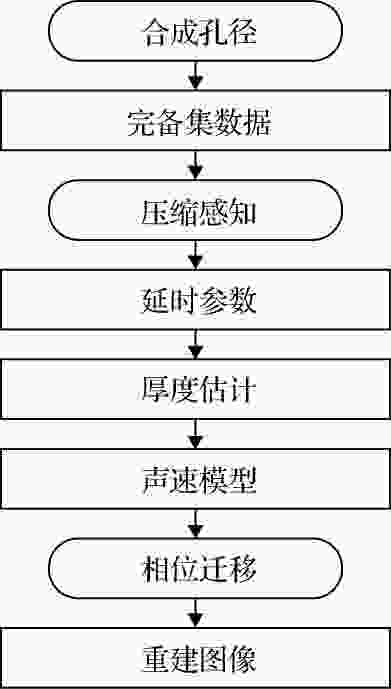
2019, 68 (18): 184302.
doi:10.7498/aps.68.20190763
Abstract +
With the advantages of non-ionizing and low cost, ultrasound imaging has been widely used in clinical diagnosis and treatment. However, due to the significant velocity changes between cortical bone and soft-tissue, the traditional ultrasound beamforming method under the assumption of constant velocity fails to reconstruct the cortical bone image. The velocity model based beamforming has been used in geophysics and non-destructive testing as an effective way to solve the challenges resulting from the velocity changes in multi-layer structure. Since the cortical bone can be modeled as a three-layer structure consisting of soft tissue, cortical bone and marrow, a multi-layer velocity model based synthetic aperture ultrasound method is introduced for cortical bone imaging. In this study, we first utilize synthetic transmit aperture ultrasound to obtain the full-matrix dataset to increase the signal-to-noise ratio. Second, a three-layer cortical bone velocity model is built with the compressed sensing estimated arriving time delay. The bases of compressed sensing consist of a series of excitation pulses with different delays. The received signals are regarded as a composition of the bases with different weights, thus can be projected into the bases by using compressed sensing. The time-delay of each received element is estimated by compressed sensing. According to the time-delay, the full-matrix dataset is reformed into a zero-offset format. By extracting the bases corresponded with the interface reflected signals, the time-delay between and the thickness values of the interfaces can be estimated. The velocity model can thus be built with the estimated cortical bone thickness. Based on the velocity model and zero-offset data, the phase shift migration method is used to reconstruct the cortical bone image. The finite-difference time-domain (FDTD) method is used to simulate the wave propagation in a 3.4-mm-thick cortical bone. The transmitting pulse is a Gaussian-function enveloped tone-burst signal with 6.25 MHz center frequency and 250 MHz iteration rate. The reconstructed image of simulation shows a clear top interface and bottom interface of cortical bone with correct thickness. Further FDTD simulations are carried out on a 3-mm-to-5-mm-thick cortical bone, and the average relative error of estimated thickness is 4.9% with a 13.5% variance.In vitroexperiment is performed on a 3.4-mm-thick bovine bone plate to test the feasibility of the proposed method by using Verasonics platform (128-element linear array). The transmitting pulse is a Gaussian-function enveloped tone-burst signal with 6.25 MHz center frequency and 25 MHz sampling rate. The reconstructed image in experiment reveals a clear top interface and bottom interface of cortical bone with correct thickness. The experiment is repeated several times and the average relative error of estimated thickness is 3.6% with a 5.4% variance. The results of simulation and experiment both indicate that compressed sensing is effective in estimating the delay parameters of the velocity model. Finally, we evaluate the capability of compressed sensing in time-delay estimation, and the result shows that compressed sensing is more accurate than Hilbert transform even in a 20 dB-noise condition. In conclusion, the proposed method can be useful in the thickness estimation and the ultrasound imaging of cortical bone.In vivoexperiment and clinical application should be further investigated.
PHYSICS OF GASES, PLASMAS, AND ELECTRIC DISCHARGES
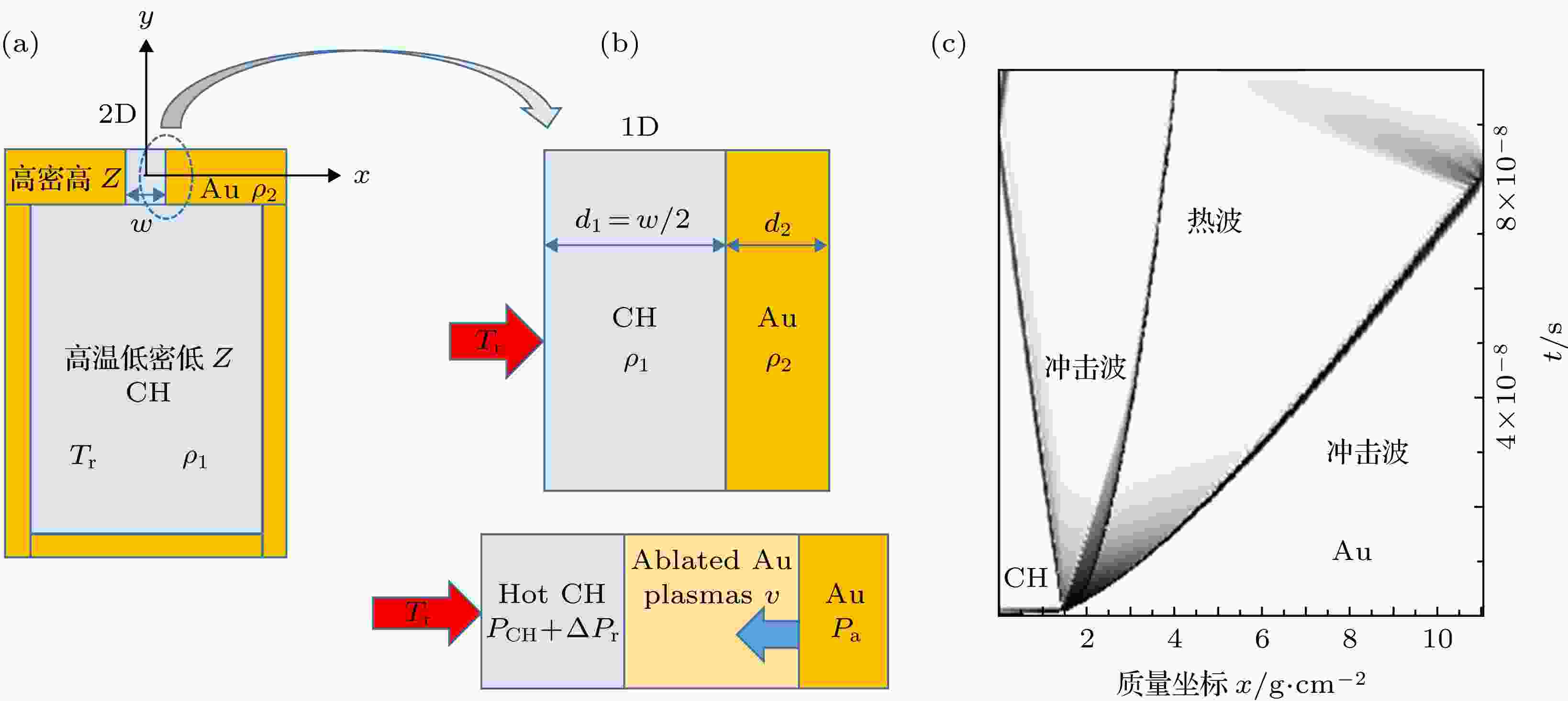
2019, 68 (18): 185201.
doi:10.7498/aps.68.20182211
Abstract +
The energy leaking through a slot in the hohlraum filled with low-Zfoams is a typical dynamic problem of the ablated high-Zplasmas. In this paper, we develop a simplified one-dimensional model to study the expansion-reverse process of the ablated Au plasmas, which corresponds to the closing-reopening process of a slot. Our work shows that its physical mechanism is the ablation pressure competing with radiation pressure difference and the material pressure of low-Zfoams. The analytical formulas for the reverse time and reverse distance of the Au plasma are deduced, respectively, indicating that the cubic value for each of both peak temperatures is proportional to the density of the low-Zfoams. The main conclusions of analytic theory are verified by numerical simulation through using the modified radiation-hydrodynamic program MULTI. It is shown that the power exponents of scaling law in high-Zplasma ablation keep unchanged in a wide range of density of low-Zfoams. The range of validity of the model is discussed.
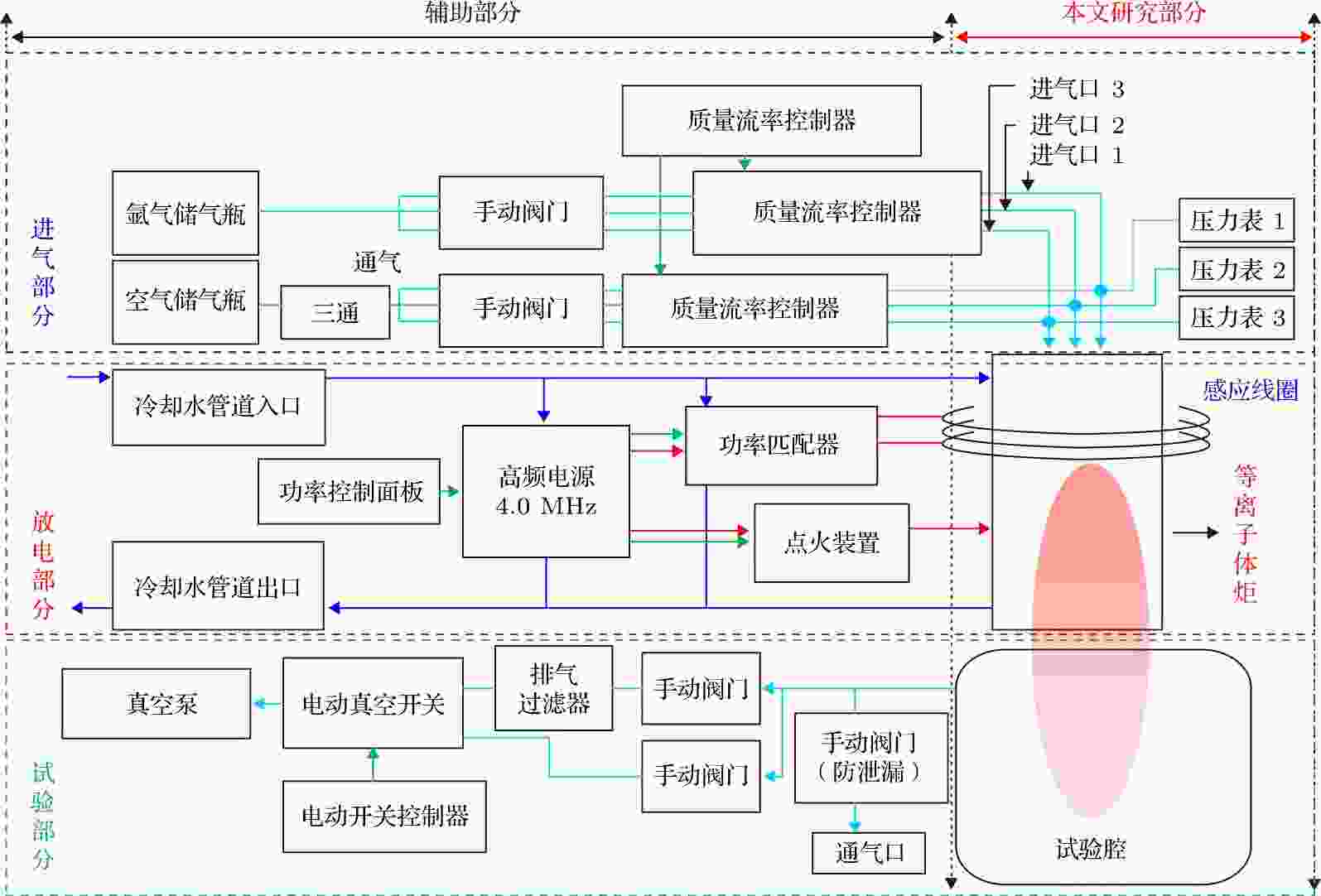
2019, 68 (18): 185202.
doi:10.7498/aps.68.20190865
Abstract +
In this paper, the inductively coupled plasma (ICP) wind tunnel, which is widely used in the development of thermal protection system for reentry vehicle in the aerospace field, is studied. The distribution properties and the interaction mechanism of the flow field and electromagnetic field are investigated by numerically solving the multi-physics fields coupling among the flow field, electromagnetic field, thermodynamic field and turbulent field. In the numerical simulation, the thermochemical non-equilibrium plasma magneto-hydrodynamic model is used to accurately simulate the high-frequency discharge, Joule heating, energy conversion, and internal energy exchange of air ICP. Finally, the distribution of electron temperature, particle number density, Lorentz force, Joule heating rate, velocity, pressure and electric field strength of air plasma are obtained through the multi-physics field coupling calculation. The results show that the plasma flow is in a thermodynamic non-equilibrium state near the torch wall in the induction coil region and that the Lorentz force plays an important role in controlling the momentum transfer. A strong eddy flow occurs between the inlet and the second turn of the inductive coil. The eddy flow has a close relationship with the negative pressure gradient and the electromagnetic heating phenomenon in the induction coil region. The radial Lorentz force is always negative. This indicates that the free electrons are generated near the wall due to the fact that the skin effect are always subjected to a force making them move to the central axis of the ICP torch. The maximum value of the radial Lorentz force is 3.95 times higher than that of the axial Lorentz. This indicates that the momentum transfer is predominantly radial. The Joule heating effect of the air particles is also affected by the radial Lorentz force. The maximum value ofEIis 2.9 times larger than the real part of electric field,ER. The positiveEIis generated by the free electrons inside the plasma. The number density of free electrons reaches a maximum value at a distance of 5.5 mm far from the inner wall surface of the torch below the second induction coil. 91% of N2are dissociated into atomic N near the central axis. The maximum electron and translational temperature simulated in this paper are 9921 K and 8507 K, respectively.

2019, 68 (18): 185203.
doi:10.7498/aps.68.20190554
Abstract +
The relativistic backward-wave oscillator has been considered to be one of the most promising high-power microwave devices. As the output microwave power is further increased, the breakdown phenomenon inside the relativistic backward-wave oscillator, including the collector pole, becomes more and more serious, which eventually leads to the pulse shortening, becoming a biggest obstacle to the development of the device with high power and high energy. Such a problem has also been one of the important issues which constrain its development. Based on the 2.5D particle-in-cell simulation software, i.e. UNIPIC-2D developed by our research group, in this paper the dynamic gassing model is used to study the effects of the relativistic backward-wave oscillator collector breakdown process and the guiding magnetic field under different outgassing coefficients. The result of particle simulation demonstrates that as the electrons continue to bombard the collector, the surface pressure of the collector is increased, and gas ionization occurs. The generated plasma enters into the slow-wave structure along the guiding magnetic field, thus affecting the beam-wave interaction process and causing the output power to drop. With the increase of the gas release coefficient, the pulse shortening phenomenon becomes more and more obvious. In the case of low guiding magnetic field, the breakdown and pulse shortening are alleviated.
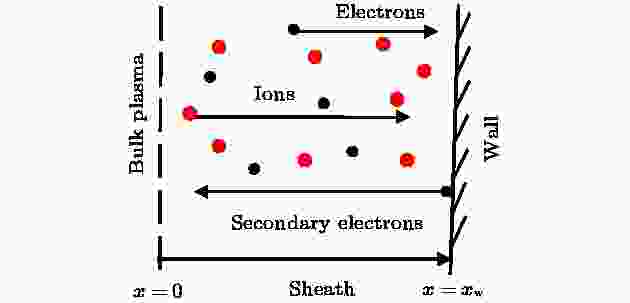
2019, 68 (18): 185204.
doi:10.7498/aps.68.20190225
Abstract +
A one-dimensional fluid model is used to investigate the characteristics of secondary electron emitted by the interaction between electrons and the wall in plasma sheath with nonextensive electrons. The study focuses on the effects of electron nonextensive parameter on Bohm criterion, the wall potential, the critical emission coefficient of secondary electrons and the density of seconday electrons in plasma sheath through numerical simulation. Some conclusions are obtained. It is shown that secondary electron is significantly affected by electron nonextensive parameter. Whether the electron distribution is superextensive or subextensive, the critical Mach number at the sheath edge increases with the secondary electron emission coefficient increasing, but decreases withq-parameter increasing. The increase ofq-parameter can cause the wall potential to increase and the critical emission coefficient of secondary electron at the wall to decrease. And for different types of plasmas, the effects of nonextensive parameter on the critical emission coefficient of secondary electron are different. The larger the mass number of ion in plasma, the smaller the influence of nonextensive parameter on the critical secondary electron emission coefficient will be. In addition, the increase of nonextensive parameter can result in the decrease of the sheath thickness and the increase of the number density of secondary electrons. It is found that the superextensive electron distribution has greater influence on the characteristics of secondary electron emission in plasma sheath than the subextensive electron distribution.
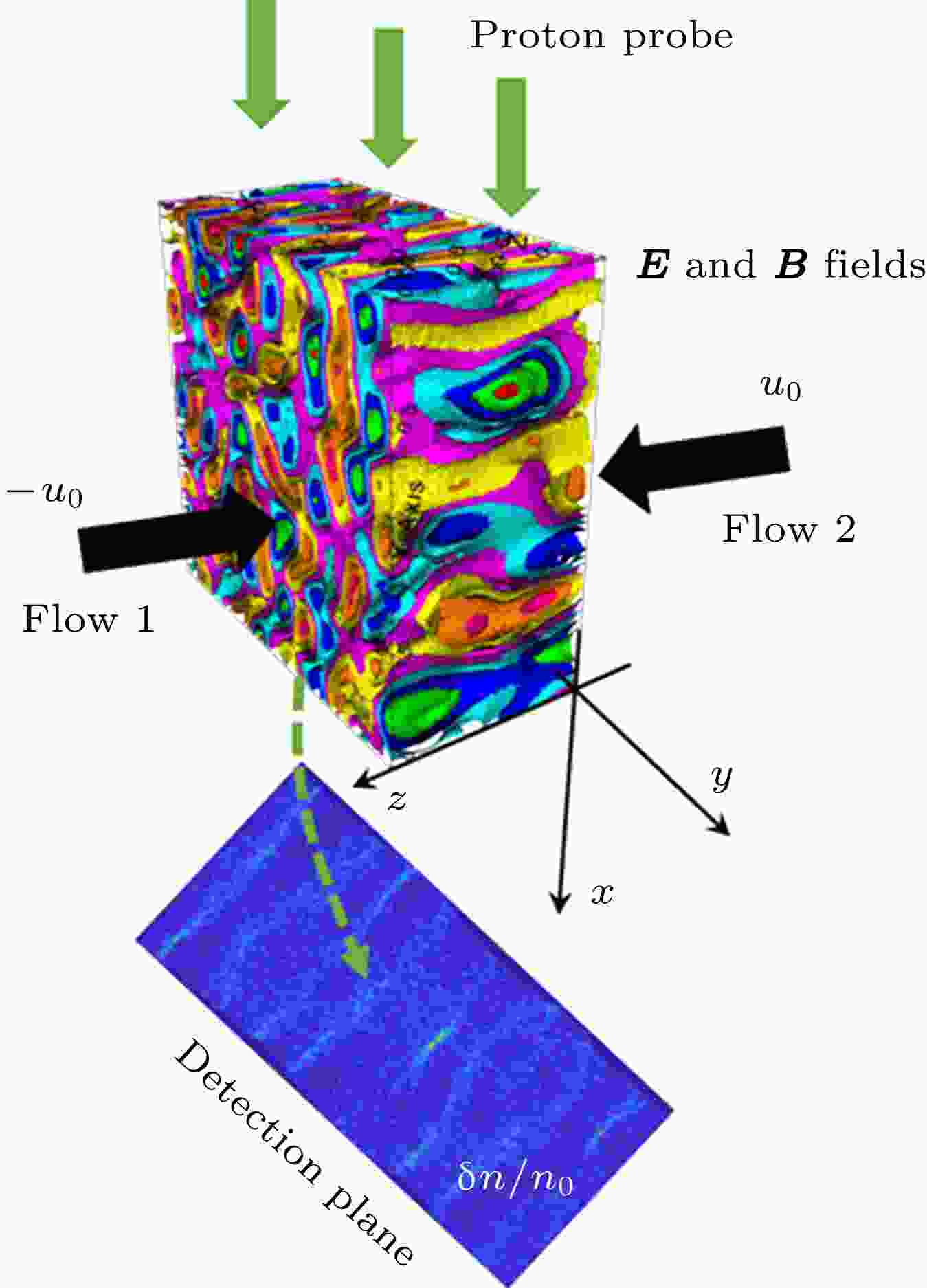
EDITOR'S SUGGESTION
2019, 68 (18): 185205.
doi:10.7498/aps.68.20190775
Abstract +
CONDENSED MATTER: STRUCTURAL, MECHANICAL, AND THERMAL PROPERTIES
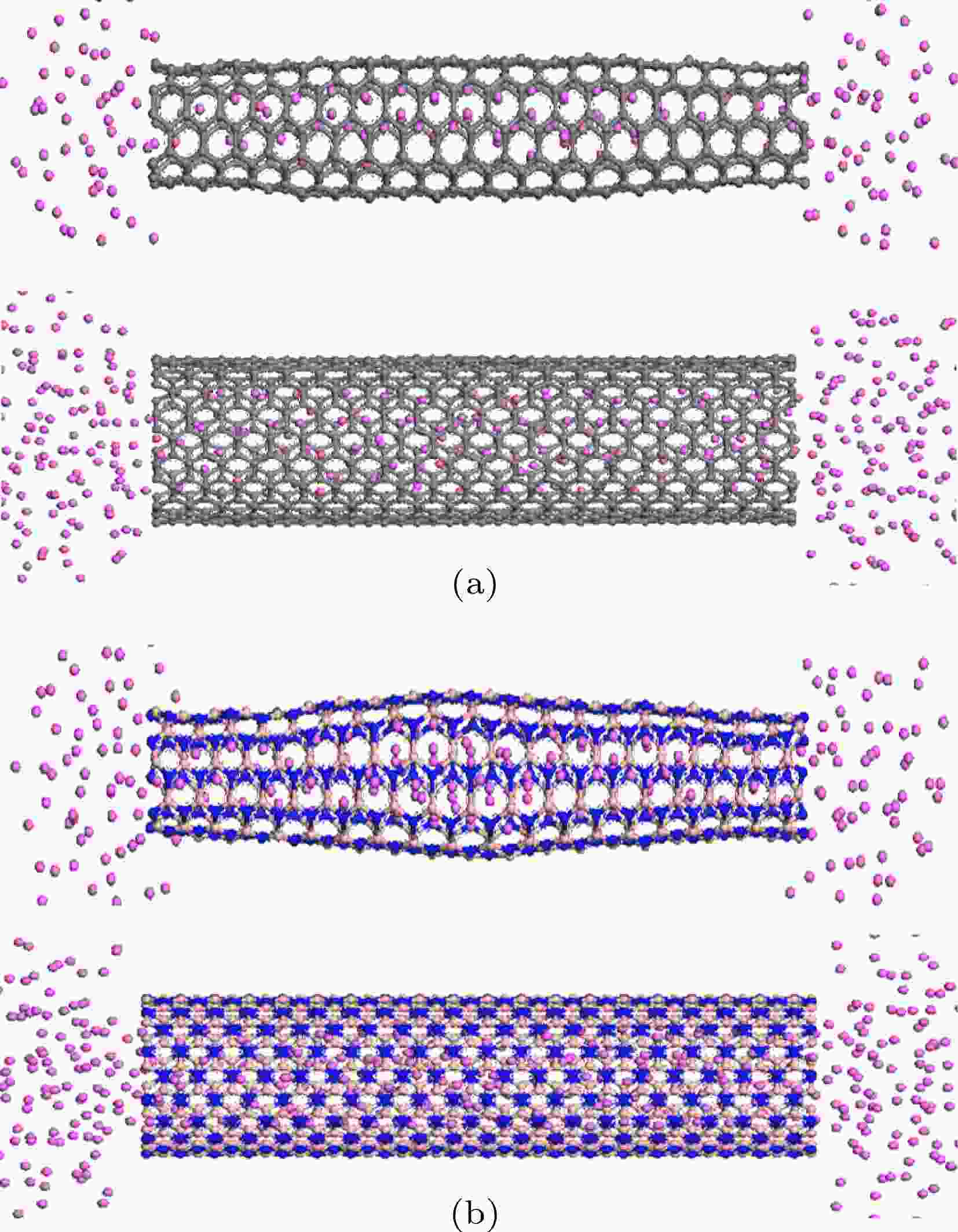
2019, 68 (18): 186101.
doi:10.7498/aps.68.20190137
Abstract +
To know the basic configuration and application characteristics of aluminum (Al) nanostructure, the structure performances of carbon nanotube (CNT) and boron-nitride NT (BNNT) filled with Al atoms are studied through molecular dynamics. Optimization results show that the Al atoms in the tube are arranged neatly into various shapes of nanowires. A bunch of one-dimensional (1D) Al nanowires (AlNWs) is formed in (5, 5) CNT and BNNT, and large beams of AlNWs are formed in (10, 10) NT, including 11 beams of 1D AlNWs with highly axial symmetry in (10, 10) CNT and 5 beams of spiral AlNWs in BNNT (10, 10). Further data analysis for radical distribution function (RDF) shows that AlNWs inside CNT have larger atomic distribution density, but those inside BNNT with larger diameter have better crystallinity than those with similar size inside the CNT. These results can provide a method of designing the nanowires with different structures and shapes in different micro-nano devices (such as nanospring, nanosolenoid, and others). Comparison of the axial compression behaviors of the composite NTs and their energy analysis reveal that the critical buckling strain of AlNW@CNT is significantly larger than that of AlNW@BNNT. For the same type of compound structure, the buckling strain decreases with NT diameter increasing. Therefore, smaller AlNW@CNT has stronger axial compressive resistance. The main reasons are as follows: 1) The AlNW in carbon NTs has a relatively large Al atomic distribution in the axial direction, which is conducive to the formation of σ bond to increase structural stability and mechanical performance. It also plays a decisive role in enhancing compressive performance. 2) The AlNW in the large-diameter boron nitride NTs is helical in shape, and more Al atoms are distributed in the direction of the cross section, thereby relatively reducing the number of axial pressure-bearing atoms. In addition, for the same type of nanotube, a tube with a small diameter results in closer hexagons to the tube wall and larger interaction. These conditions are more conducive to resisting the transverse subsidence under axial pressure. The energy analysis results indicate that the van der Waals force is one of the main causes for NT composite stability and increasing compressive strength. These results can provide a reference for selecting different Al nanowire-reinforced composite structures under different application conditions, such as high temperature, high pressure, oxidation resistance, and others.
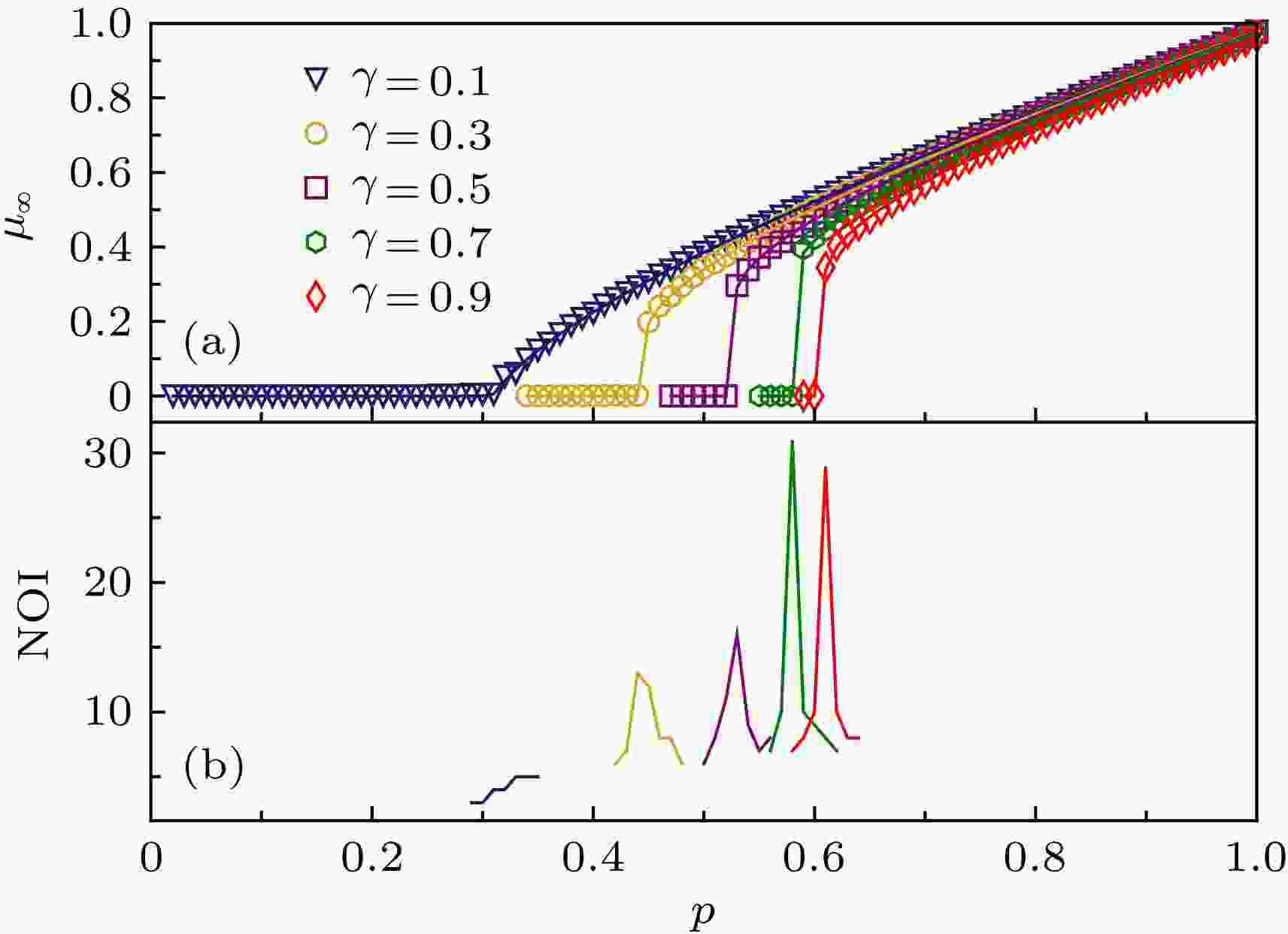
2019, 68 (18): 186401.
doi:10.7498/aps.68.20190761
Abstract +
The robustness of complex networks plays an important role in human society. By further observing the networks on our planet, researchers find that many real systems are interdependent. For example, power networks rely on the Internet to transfer operation information, predators have to hunt for herbivores to refuel themselves, etc. Previous theoretical studies indicate that removing a small fraction of nodes in interdependent networks leads to a thorough disruption of the interdependent networks. However, due to the heterogeneous weak inter-layer links, interdependent networks in real world are not so fragile as the theoretical predictions. For example, an electronic components factory needs raw materials which are produced by a chemical factory. When the chemical factory collapses, the electronic components factory will suffer substantial drop in the production, however, it can still survive because it can produce some other raw materials by itself to sustain its production of some products. What is more, because of the heterogeneity on real industry chains, different electronic components factories produce different kinds of products, which still guarantees the diversity of electronic goods on the whole. In this paper, we develop a framework to help understand the robustness of interdependent networks with heterogeneous weak inter-layer links. More specifically, in the beginning, a fraction of 1–pnodes are removed from networkAand their dependency nodes in networkBare removed simultaneously, then the percolation process begins. Each connectivity link of a node with weak inter-layer dependency is removed with a probabilityγafter the failure of its counterpart node. Theγvalues for different nodes are various because of heterogeneity. At the end, the nodes can survive as long as one of the remaining connectivity links reaches the giant component. We present an analytical solution for solving the giant component size and analyzing the crossing point of the phase transition of arbitrary interdependent random networks. For homogeneous symmetric Erdös-Rényi networks, we solve the continuous transition point and the critical point ofγ. The simulation results are in good agreement with our exact solutions. Furthermore, we introduce two kinds ofγdistributions to analyze the influence of heterogeneous weak inter-layer links on the robustness of interdependent networks. The results of both distributions show that with the increase of heterogeneity, the transition pointpcdecreases and the networks become more robust. For the first simpleγdistribution, we also find the percolation transition changes from discontinuous one to continuous one by improving the heterogeneity. For the second Gaussianγdistribution, a higher variance makes the interdependent networks more difficult to collapse. Our work explains the robustness of real world interdependent networks from a new perspective, and offers a useful strategy to enhance the robustness by increasing the heterogeneity of weak inter-layer links of interdependent networks.

2019, 68 (18): 186801.
doi:10.7498/aps.68.20190692
Abstract +
The interface dynamic behavior of borophene is one of the issues that need investigating for its applications. In this paper, the interaction between graphene and borophene, h-BN is investigated. The results show that the interactions between C atoms and B atoms are weaker than those between C atoms and N atoms when graphene slides on h-BN substrate. The corrugation of interface potential between graphene and borophene is smaller than between graphene and h-BN, which implies smaller friction. Moreover, the pull-out force in the simulation system including graphene and borophene is smaller than the interaction between graphene and h-BN, which indicates a weaker boundary effect. Therefore, borophene promises to exhibit an excellent tribological behavior in application.
CONDENSED MATTER: ELECTRONIC STRUCTURE, ELECTRICAL, MAGNETIC, AND OPTICAL PROPERTIES

2019, 68 (18): 187101.
doi:10.7498/aps.68.20190503
Abstract +
Silicate cathode material Li2CoSiO4has received wide attention due to high theoretical capacity. However, the high discharge makes the existing electrolyte unable to satisfy the requirements of its use, and the poor cyclic stability limits its further application and development. The high discharge and cycle stability of Li2CoSiO4cathode material can be improved by doping corresponding elements. The effects of non-transition high-valent elements of Ga, Ge and As doping on structural, electrochemical and electronic properties of Li-ion battery cathode material Li2CoSiO4are systematically studied by the first-principles calculations based on density functional theory within the generalized gradient approximation with Hubbard corrections (GGA +U). The calculation results show that the maximum expansion range of the unit cell volume of Li2CoSiO4cathode material during lithium ion removal is 3.5%. However, the Ga, Ge and As doping reduce the variation range of unit cell volume during the delithiation of the system, which is beneficial to the improvement of the cycle stability of Li2CoSiO4material. Furthermore, the Ga, Ge and As doping can reduce the theoretical average deintercalation voltages of extraction for the first Li+in per formula unit; the theoretical average deintercalation voltages of the doping systems decrease by 1.65 V, 1.64 V and 1.64 V, respectively, compared with the deintercalation voltage of the undoped Li2CoSiO4system. Meanwhile, except for the Ga doping, the Ge and As doping can also effectively reduce their theoretical average deintercalation voltagesin the secondary delithiation process. The density of states and magnetic moment show that Co2+has a strong binding effect on the 3d orbital electrons, which makes it difficult for Co2+in Li2CoSiO4material to lose electrons for participating in the charge compensation in the process of Li+removal. However, the Ga, Ge and As doping can effectively participate in the charge compensation of the system in the process of Li+removal, which is the main reason for the decrease of the theoretical average deintercalation voltage of the system. In addition, the Ge doping reduces the band gap value of the Li2CoSiO4from 3.7 eV to 2.49 eV, while the Ga doping and the As doping introduce the donor defects, and thus making the doping system exhibit metallic properties, which can improve the conductivity of the system to some extent.
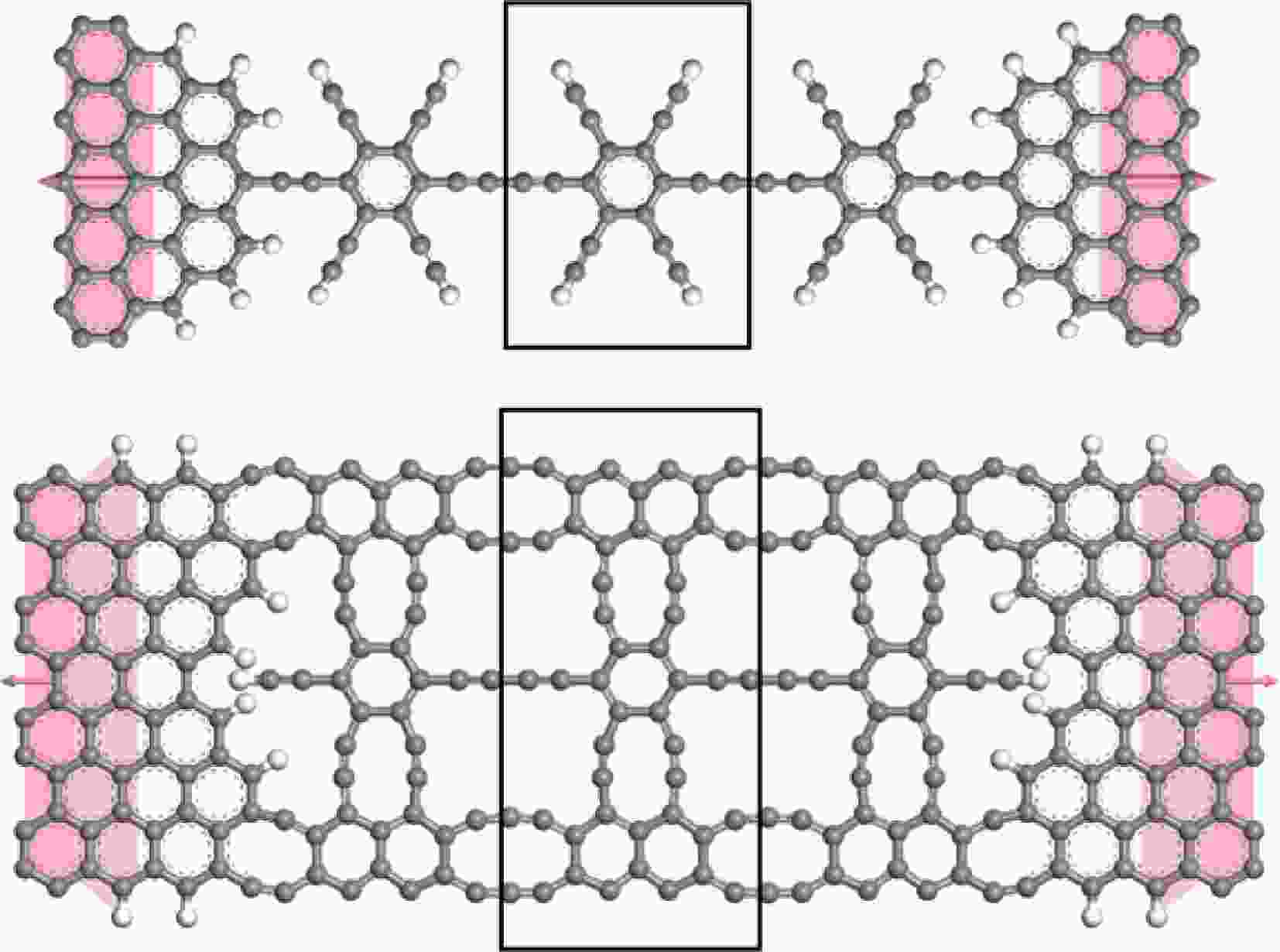
2019, 68 (18): 187102.
doi:10.7498/aps.68.20190859
Abstract +
Resonant tunneling transistors have received wide attention because of their ability to reduce the complexity of circuits, and promise to be an efficient candidate in ultra-high speed and ultra-high frequency applications. The chemical compatibility between graphene and graphdiyne implies that they can be combined into various configurations to fulfill ultra-high frequency nanotransistor. In the present paper, two novel resonant tunneling transistors based on graphene/graphdiyne/graphene double-heterojunction are theoretically developed to model two new kinds of bipolar devices with two representative graphdiyne nanoribbons. The electronic structures of two pristine graphdiyne nanoribbons are investigated by performing the first-principles calculations with all-electron relativistic numerical-orbit scheme as implemented in Dmol3 code. The electronic transport properties including quantum conductance (transmission spectrum) and electrical current varying with bias-voltage for each of the designed graphdiyne nanoribbon transistors are calculated in combination with non-equilibrium Green function formalism. The calculated electronic transmission and current-voltage characteristics of these transistors demonstrate that the current is dominantly determined by resonant tunneling transition and can be effectively controlled by gate electric field thereby representing the favorable negative-differential-conductivity, which is the qualified attribute of ultra-high frequency nanotransistor. It follows from theI-Ubvariations explained by electronic transmission spectra that quantum resonance tunneling can occur in the proposed star-like graphdiyne (SGDY) and net-like graphdiyne (NGDY) nanoribbon transistors, with the resonance condition limited to a narrow bias-voltage range, leading to a characteristic resonant peak inI-Ubcurve, which means the strong negative differential conductivity. Under a gate voltage of 4 V, when the bias-voltage rises up to 0.6 V (0.7 V), the Fermi level of source electrode aligns identically to the quantized level of SGDY (NGDY) nanoribbon channel, causing electron resonance tunneling as illustrated by the considerable transmission peak in bias window; once the source Fermi level deviates from the quantized level of SGDY (NGDY) channels at higher bias-voltage, the resonance tunneling transforms into ordinary electron tunneling, which results in the disappearing of the substantial transmission peak in bias window and the rapid declining of current. The designed SGDY and NGDY nanotransistors will achieve high-level negative differential conductivity with the peak-to-valley current ratio approaching to 4.5 and 6.0 respectively, which can be expected to be applied to quantum transmission nanoelectronic devices.

2019, 68 (18): 187103.
doi:10.7498/aps.68.20190728
Abstract +
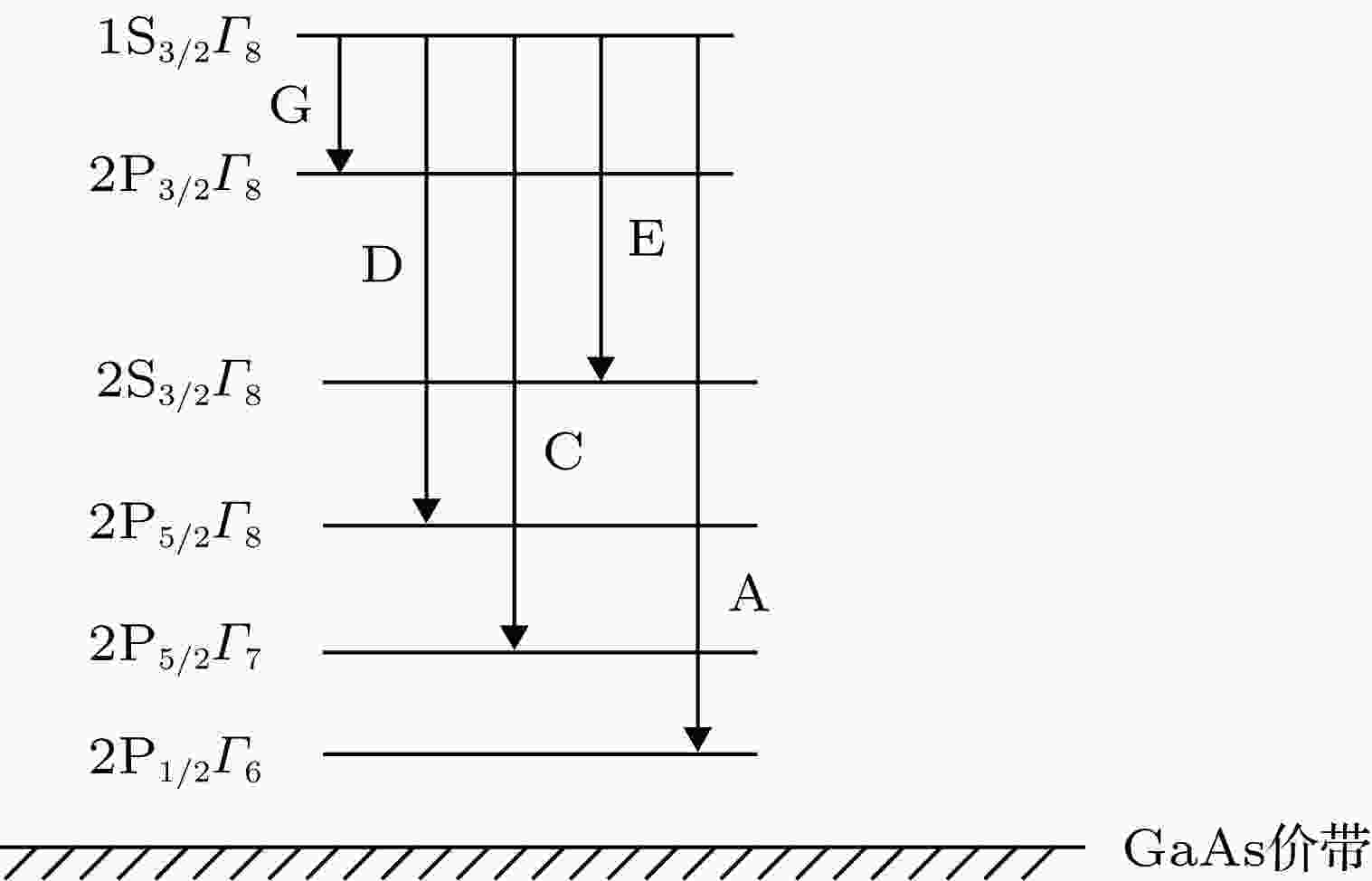
2019, 68 (18): 187104.
doi:10.7498/aps.68.20190254
Abstract +
The doping is one of important means in the semiconductor manufacturing techniques, by which the optical and electric properties of semiconductor materials can be significantly improved. The doping level and energy level structure of dopants have a great influence on the operating performances of micro-electronic devices. Beryllium is one of acceptors, which is frequently used to be doped in GaAs bulk, because it is very stable with respect to diffusion at higher temperatures. Therefore, it is significant for the application to optoelectronic devices that the energy-state structure of Be acceptors in GaAs bulk can be investigated in detail. The sample GaAs:Be used in experiment is a 5-μm-thick epitaxial single layer doped uniformly by Be acceptors with a doping level of 2 × 1016cm–3, and grown by molecular beam epitaxy on 450-μm-thick semi-insulating (100) GaAs substrates in a VG V80 H reactor equipped with all solid sources. The transitions between the energy states of Be acceptors are studied experimentally by different spectroscopy techniques. The far-infrared absorption experiments are performed by using a Fourier-transform spectrometer equipped with a tungsten light source and a multilayer wide band beam splitter. Prior to the absorption spectrum measurement, the sample is thinned, polished and wedged to approximately a 5° angle to suppress optical interference between the front and back faces. Then, the sample is placed into the cryostat with liquid helium (4.2 K). The photoluminescence and Raman spectra are also measured at 4.2 K by a Renishaw Raman imaging microscope. The optical excitation to the sample is provided by an argon-ion laser with a wavelength of 514.5 nm, and the excited power is typically 5 mW. The odd-parity transitions from the Be acceptor ground state 1S3/2Γ8to three excited states, i.e. 2P3/2Γ8, 2P5/2Γ8and 2P5/2Γ7are clearly observed in the far-infrared absorption spectra, then the respective transition energy values are obtained, which are in excellent agreement with the experimental results reported previously. In the photoluminescence spectrum, the emission peak labelled two holetransition, originating from the two-hole transition of recombination of the neutral-accptor bound excitons, is seen obviously, thus the energy of the even-parity transition between 1S3/2Γ8and 2S3/2Γ8states is found indirectly. Furthermore, in the Raman spectrum measured, the transition peak between 1S3/2Γ8and 2S3/2Γ8states is well resolved, and the transition energy between them is gained directly. By comparison, the transition energy values gained directly and indirectly are found to be consistent with each other.
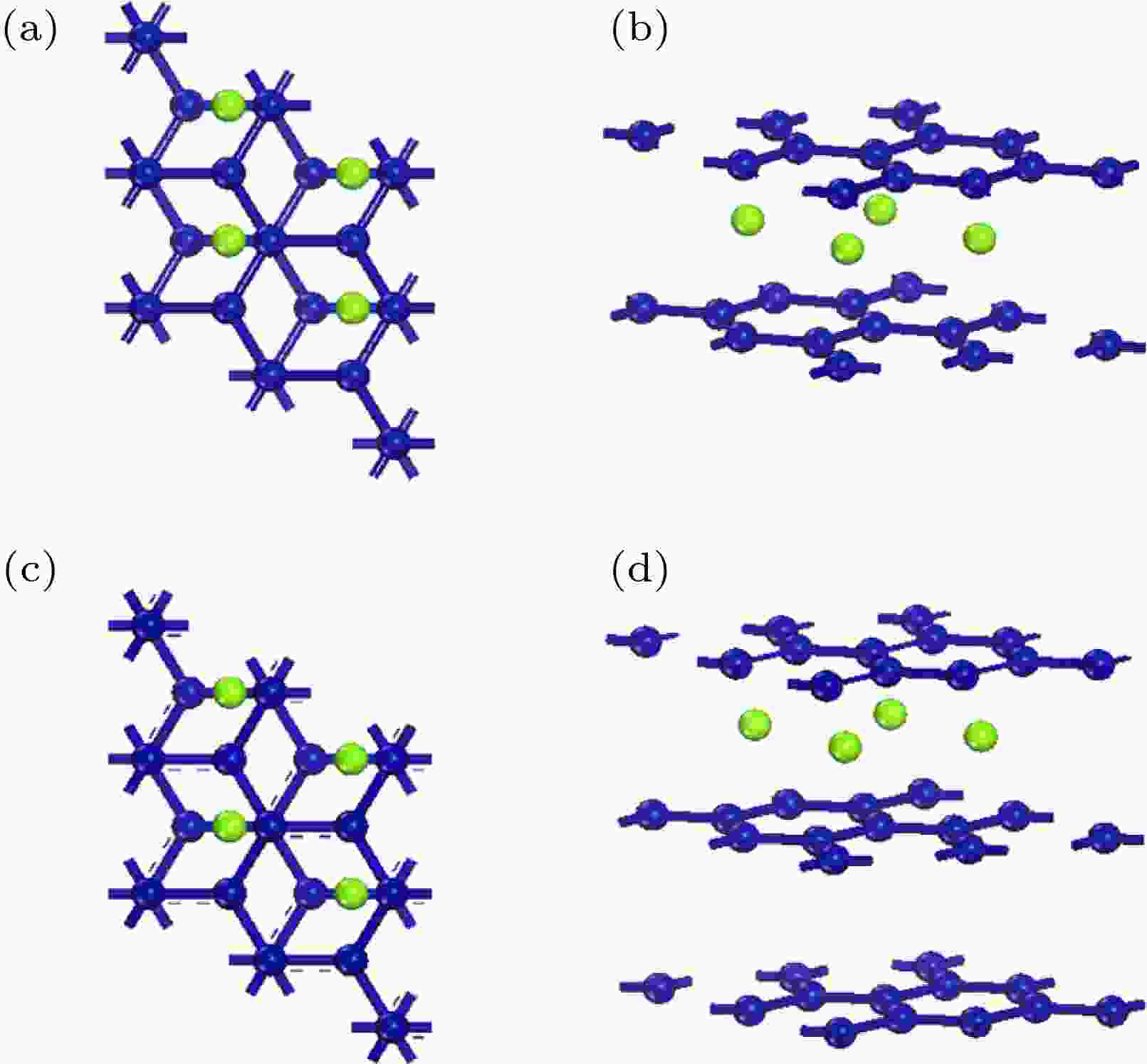
2019, 68 (18): 187301.
doi:10.7498/aps.68.20190523
Abstract +
Graphene is an ideal two-dimensional crystal with the advantages of high conductivity, unique physical and chemical properties, and high specific surface area. Especially, because of its super excellent electronic properties, graphene may substitute the traditional semiconductor silicon material and carbon nanotube, thus creating a new nanoscale electronic device. In addition, multilayer graphene with ultra-wide spectral absorption characteristics and unique photoelectric properties is an ideal material for photovoltaic devices. However, the zero band gap and semi-metality of graphene both limit its application in space detectors such as the microelectronic industries and satellites. Opening and regulating the graphene band gap by physical methods has become one of the key means to further expand its applications. Research work has shown that the doping of elements can significantly change the electronic structure of graphene, thereby regulating the optical properties of graphene. In order to provide an insight into electronic properties of graphene and tune its electronic band structure and optical properties effectively, electronic and optical properties of Ni-doped multi-layer graphene are studied and a number of interesting results are obtained. The calculation are carried out by the CASTEP tool in Materials Studio software based on the first-principles of ultrasoft pseudopotential of density functional theory. The models of three typical doping positions relative to carbon atoms are constructed. After structural optimization, it is obtained that " above the center of two carbon atoms” is the most stable doping structure. By using the method of local density approximation, the band structure, density of states, dielectric constant, reflectivity and refractive index of the models are calculated. The results show that an enhanced energy band gap can be achieved after nickel-doping, and reach up to 0.604 eV. Besides, peaked phenomenon of density of states at Femi level can be observed, which is accomplished by enhancing the plasma energy. Furthermore, the calculations show that the imaginary part of permittivity and refractive index increase after nickel-doping, suggesting that the optical absorbing performance is improved. All these results provide theoretical guidance for further exploring the optical properties of graphene.
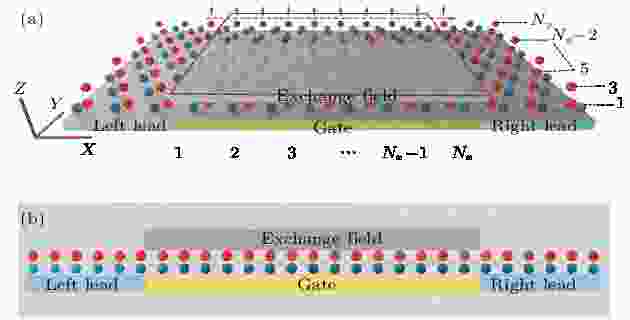
COVER ARTICLE
2019, 68 (18): 187302.
doi:10.7498/aps.68.20190817
Abstract +
Germanene, which has been synthesized recently, is a single-layered material composed of germanium atoms. Almost all the striking properties of graphene can be transferred to germanene, because both of them have the same honeycomb lattice structure. In contrast with graphene, germanene has a sizable band gap and spin dependent helical edge states, which make it attractive candidate for spintronic applications. By using the nonequilibrium Green’s function method, the effects ofZ-axis local exchange field and electric field on spin-polarized transport properties in germanene nanoribbon are studied theoretically. The results reveal that by exerting an exchange field with a strength greater than twice the effective spin-orbit coupling to the edge region of germanene, the spin resolved band gaps can be generated in different energy ranges, and thus 100% filtering of spin-up or spin-down electrons can be achieved. We theoretically propose a method to reduce the threshold exchange field strength for the spin filter effect by using the electric field. The results show that the spin-filter effect can be achieved in a larger energy range under a weaker exchange field when the electric field are applied to the entire central device region. With the increase of the local exchange field intensity, the energy range corresponding to the spin filter effect will increase significantly.
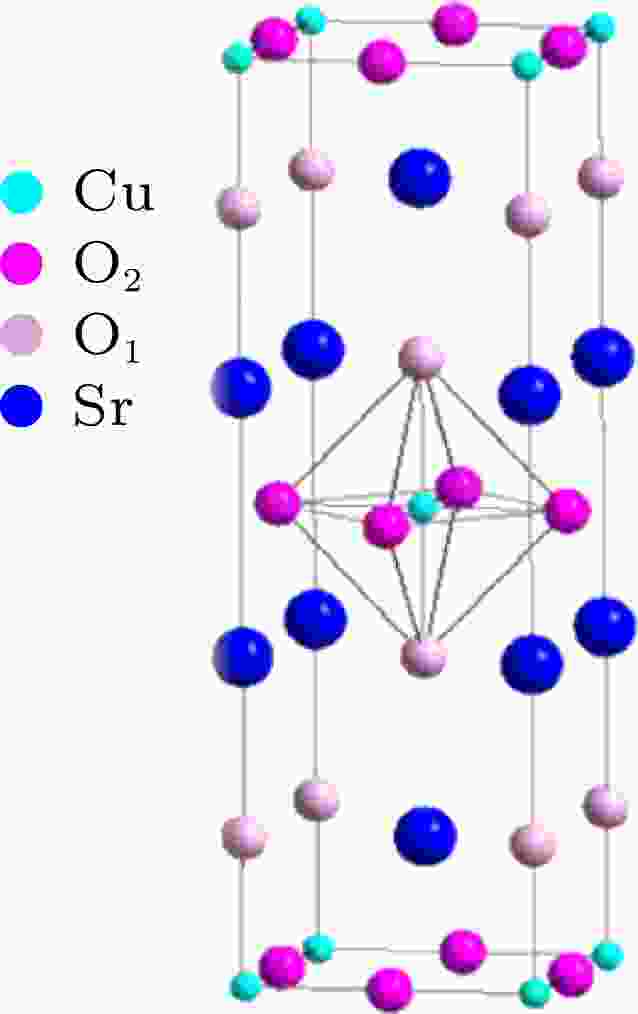
2019, 68 (18): 187401.
doi:10.7498/aps.68.20190494
Abstract +
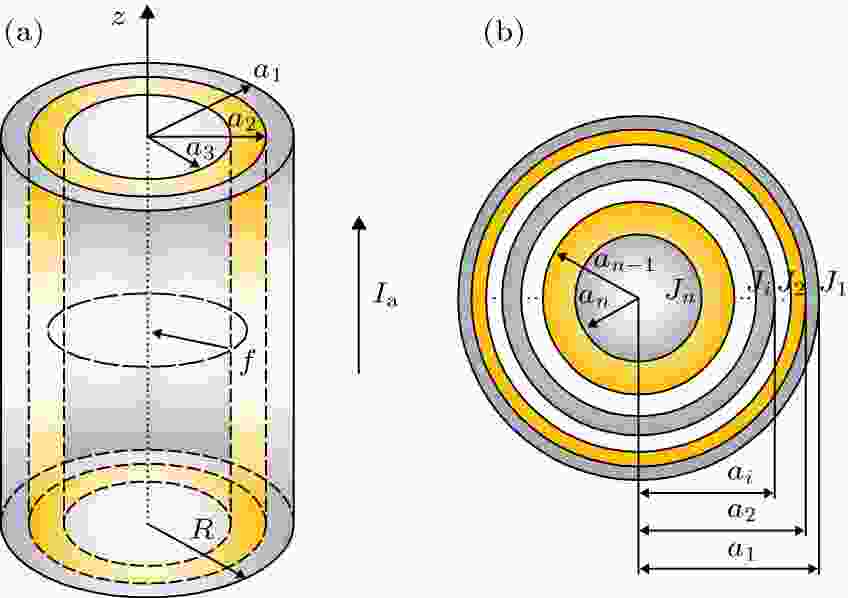
2019, 68 (18): 187402.
doi:10.7498/aps.68.20190759
Abstract +
High-temperature superconductor has high critical temperature, high transport current capacity and low energy consumption, which correspondingly offer the wide applications in the field of electric power. As an important concern, the mechanical properties of superconductor carried with transport current have received extensive attention. Still, its mechanical properties in various electromagnetic environments are under study. Most of previous studies are based on the assumption of uniform distribution of critical current density, and only few researches based on the non-uniform distribution of critical current density are carried out. In this work, the mechanical flux pinning response of cylindrical superconducting structures is studied. Considering the non-uniform features of critical current density along the radial direction, the distribution law of induced magnetic field and current for the cylindrical superconducting structure is obtained based on the Bean model. Combined with the plane strain method, the analytical expression of magnetic flux pinning force, stress and magnetostriction in the superconducting structure are obtained. The results show that the uneven distribution of critical current density causes the flux pinning force to change, which further leads the superconductor`s local radial stress to vary with the critical current density. When the transport current flowing through the superconductor is increased in the ascending field, the radial stress and the hoop stress both appear compressive. The non-uniform distribution of critical current density has no significant effect on the overall trend of the internal stress, but displays an obvious influence on the stress distribution, and the superconducting structure is compressed and deformed. The results are consistent with those in the uniform case. When the transport current decreases during field descending, the critical current starts to reverse from the outermost part, then the compressive stress and tensile stress exist simultaneously. The hoop stress has a discontinuous point at the discontinuous portion of the critical current density, thus the damage probability is higher than that of the uniform distribution. In other words, the shear strength of superconductor is required to be higher for application. Also, the degree of magnetostriction is higher when the distribution of critical current density is set to be uniform, that is, the non-uniform distribution of the critical current density causes the superconducting structure to undergo greater deformation. Therefore, in engineering applications, the structural strength of the superconducting material must be enhanced to cope with the challenge from the uneven distribution of critical current density.
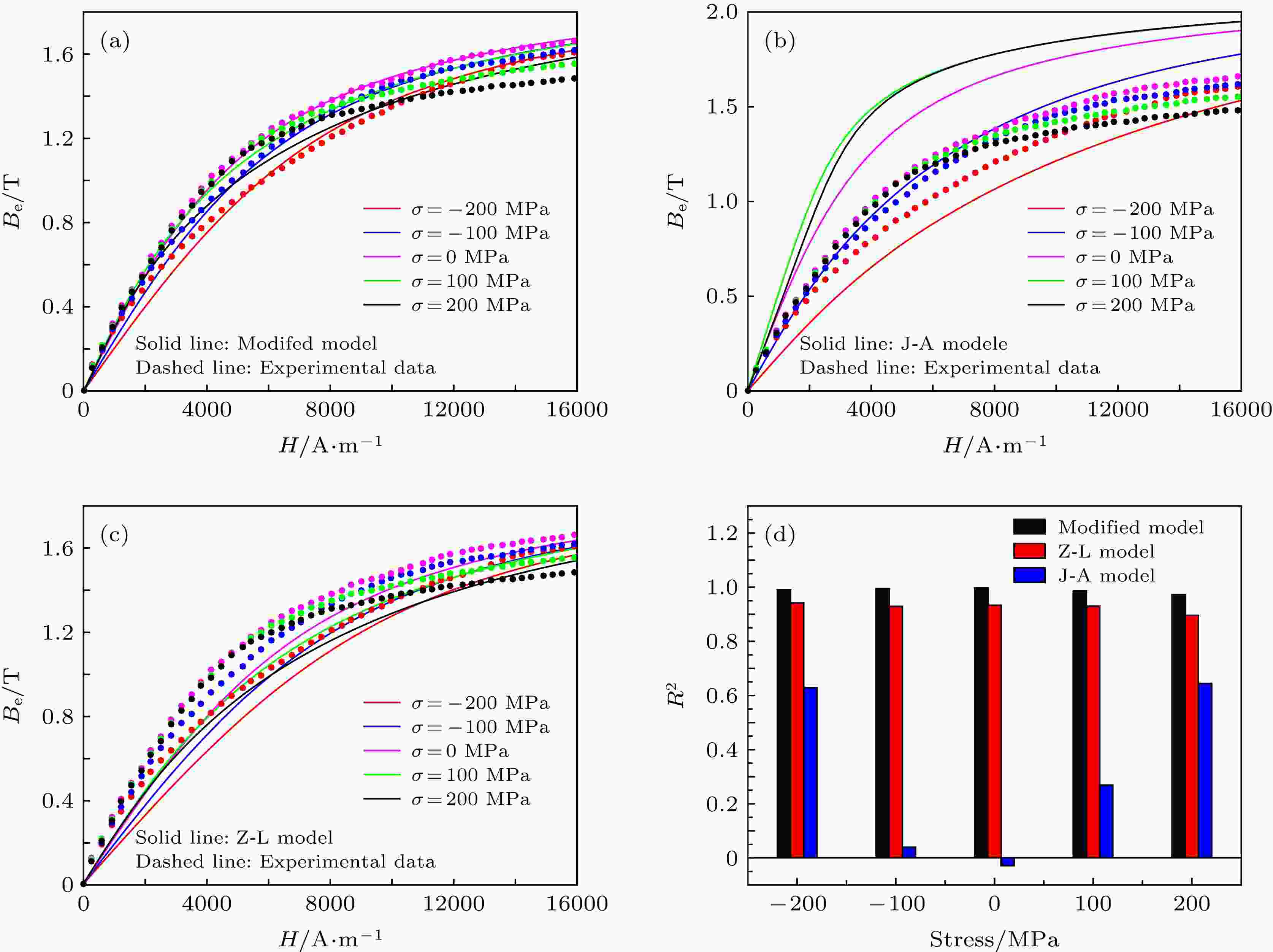
2019, 68 (18): 187501.
doi:10.7498/aps.68.20190765
Abstract +
The prevailing Jiles-Atherton (J-A) model and Zheng Xiao-Jing-Liu Xing-En (Z-L) model are extensively used in modeling the magneto-mechanical effect on magnetization in ferromagnetic materials. In the J-A model, a fitting formula of magnetostrictive strain interms of stress and magnetization is adopted to model the stress effect on magnetostriction. However, the fitting formula is not in good accordance with the experimental results obtained by Kuruzar and Culllity. In order to solve this problem, a transcendental function tanh(x) is appropriately selected to describe the nonlinear magnetostrictive strain in the Z-L model, and it is found that the general formula of magnetostrictive strain is more effective to describe the nonlinear relation of magnetostrictive strain with stress and magnetization. Then, the modified law proposed by Jiles and Li is adopted to modify the Z-L model by Shi Pengpeng to describe the hysteretic behavior; nevertheless, the effect of Weiss molecular field, pinning energy and plastic deformation on magnetization are not taken into account, and the modified Z-L model can only describe the elastic stress effect on magnetization. In order to solve these problems above, a modified magneto-mechanical model is established by combining the magnetostrictive constitutive relationships of Z-L model with the modified energy conservation equation of J-A model, as well as taking the effect of elastic stress and plastic strain on the model parameters into account simultaneously. It is found that the predictions of proposed model here are in better accordance with the initial magnetization curves given by Jiles and Atherton and the hysteresis loops obtained by Makar and Tanner under different stresses and plastic deformation than those calculated by the J-A model and Z-L model. The correlation coefficients between experimental data and theoretical results calculated by the modified model are all over 0.98, which indicates that the modified model here is more effective than the existing model. A detailed study also performed to reveal the effects of the elastic tensile and compressive stress and plastic tensile and compressive strain on hysteresis loops, coercivity and remanence. The proposed model reveals that the area of hysteresis loop and coercivity increase nonlinearly with the stress and plastic deformation increasing, while the remanence decreases significantly; the effects of compressive stress and compressive plastic deformation on magnetization characteristic parameters above are more significant than those of tensile stress and tensile plastic deformation, which is consistent with the experimental trend. The proposed model can be used to quantitatively analyze the magneto-mechanical effect on the magnetization of ferromagnetism.
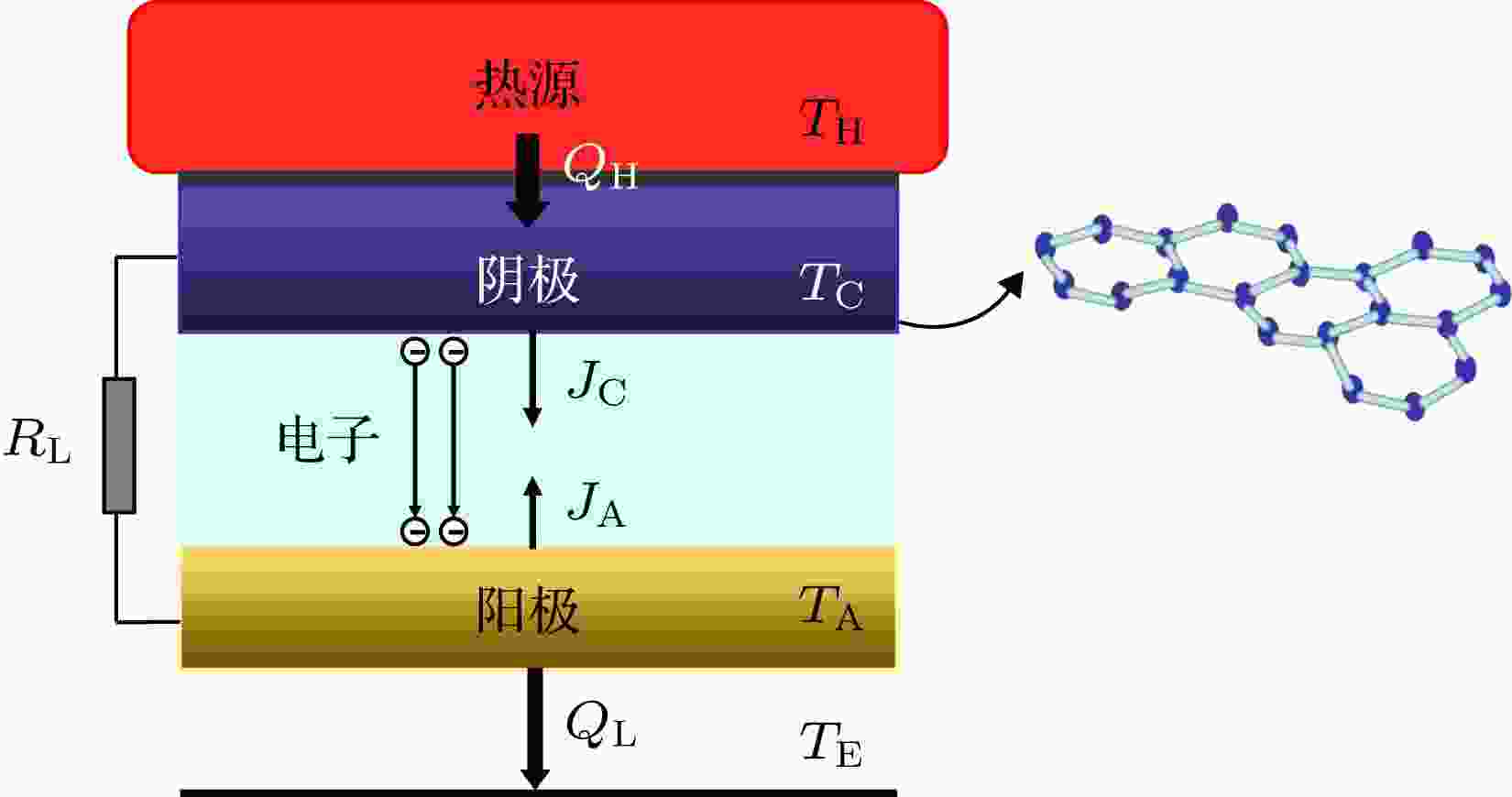
2019, 68 (18): 187901.
doi:10.7498/aps.68.20190882
Abstract +
According to the theories of the solid physics and irreversible thermodynamics, the performance characteristics of a novel high-efficient graphene thermionic power device (TPD) are studied. The temperature of the cathode plate and anode plate are determined by solving the energy balance equation of hot and cold sides of the TPD. The effects of the output voltage and the work function of the cathode on the volt-ampere characteristics of the TPD and the temperature of the two electrodes are analyzed to determine the parametric characteristics of the TPD at the maximum power density and efficiency. The power density and efficiency are compromised, and the parametric optimal designs are given. The influence of the temperature of heat source at high temperature on optimization performance is analyzed. The results obtained here can provide theoretical guidance for developing the thermionic energy conversion devices.
INTERDISCIPLINARY PHYSICS AND RELATED AREAS OF SCIENCE AND TECHNOLOGY
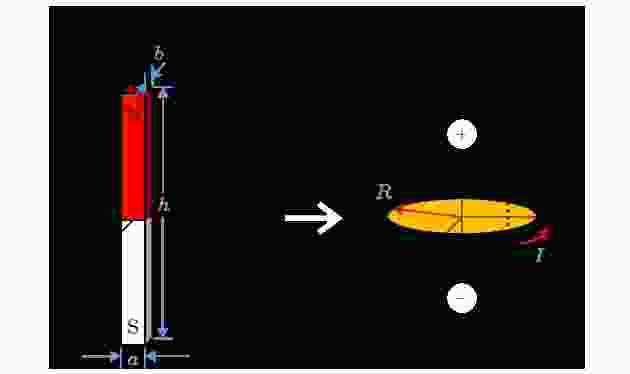
2019, 68 (18): 188401.
doi:10.7498/aps.68.20190339
Abstract +
Long wavelength results in the low radiation efficiency of a portable conventional antenna operating at very low frequency (VLF) and below. This has motivated one to develop an innovative approach to design an electrically small antenna in a frequency band lower than VLF. The time-varying electromagnetic fields can be generated by spinning a permanent magnet. In this way, the mechanical energy is converted to the electromagnetic energy, and the impedance matching networks with nonnegligible insertion loss are not required. Therefore, this mechanical antenna with spinning magnet can improve radiation efficiency in a low frequency band. In this paper, we give the detailed analysis procedure for the spinning magnet, which is seldom discussed in other published reports. In order to analyze the electromagnetic characteristics of the spinning magnet, in this paper we use the ampere return circuit theorem to investigate the equivalent relation between a spinning magnet and the orthogonal magnetic dipole. We introduce an initial spinning angle of the magnet into the dyadic green’s function. With this modification, we provide the rigorous analytic formula for field computation of the orthogonal magnetic dipole. Thus the electromagnetic characteristics of the spinning magnet and spinning magnet array can also be analyzed. For a spinning NdFeB magnet with a magnetization ofBr= 0.8 T and a volume ofVr= 270 cm3as well as 9600 revolutions per minute, the simulation results reveal that the magnetic field of 15 fT at 1 km in air space can be obtained. But the magnetic field of the spinning magnet decreases quickly to 1 fT at 250 m in sea water. Considering the potential demand for increasing the field strength in the near field region, we recommend to use a magnet array with small-sized elements. The magnet array can be used to control the near field pattern. We take two magnets as an example for studying the performance. It can be found from the simulation results that the magnetic near field is increased by 3 dB with the linear magnet array consisting of two elements. With the initial spinning angle of the magnet element adjusted, the near field pattern of the magnet array can be controlled. This is analogous to beam steering of traditional phased array for high band operation. It can be concluded from our study that the spinning magnet is a possible alternative solution for low frequency small transmitter antenna.









